2021 Honor Roll | 2021 Financials
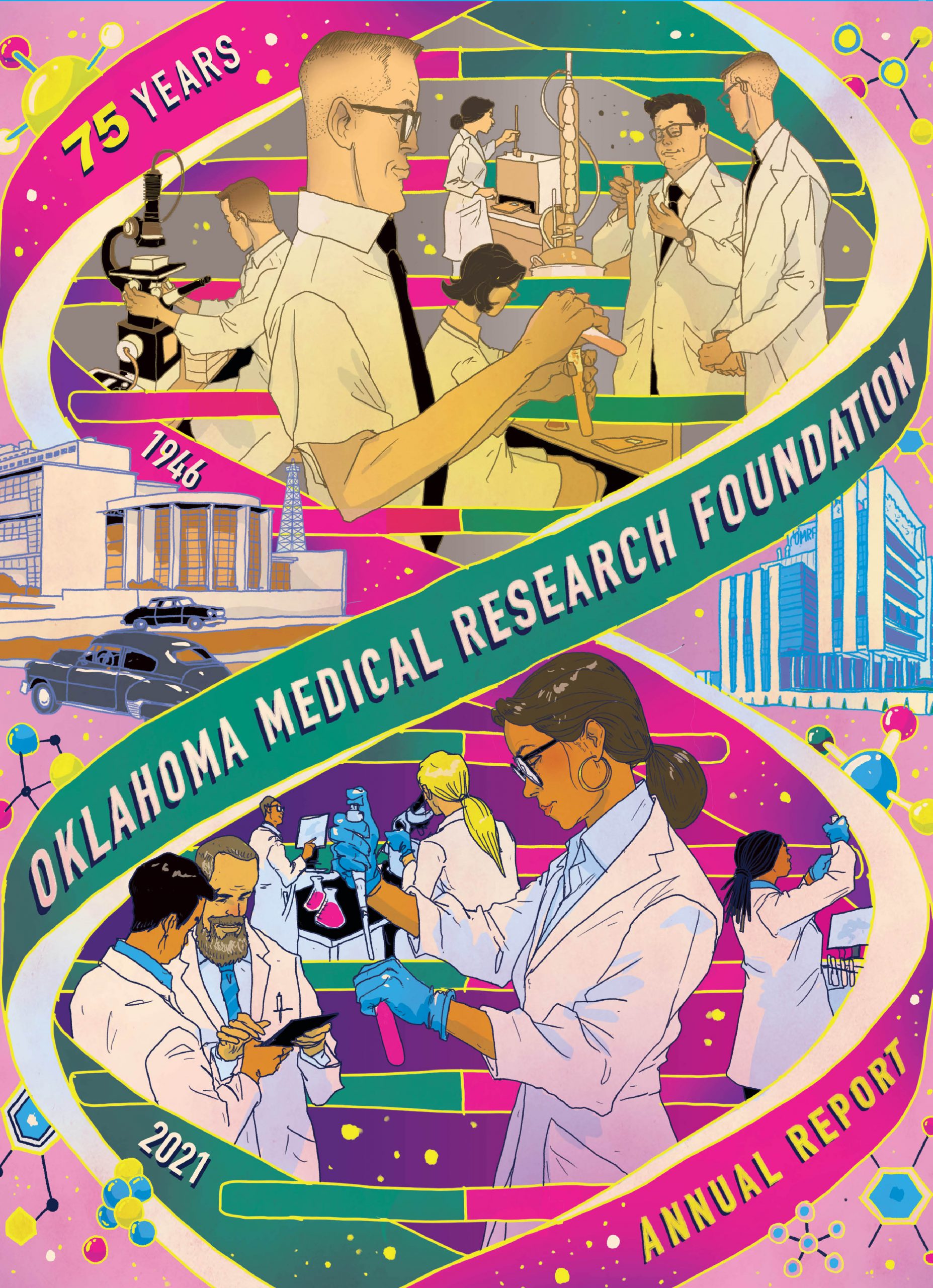
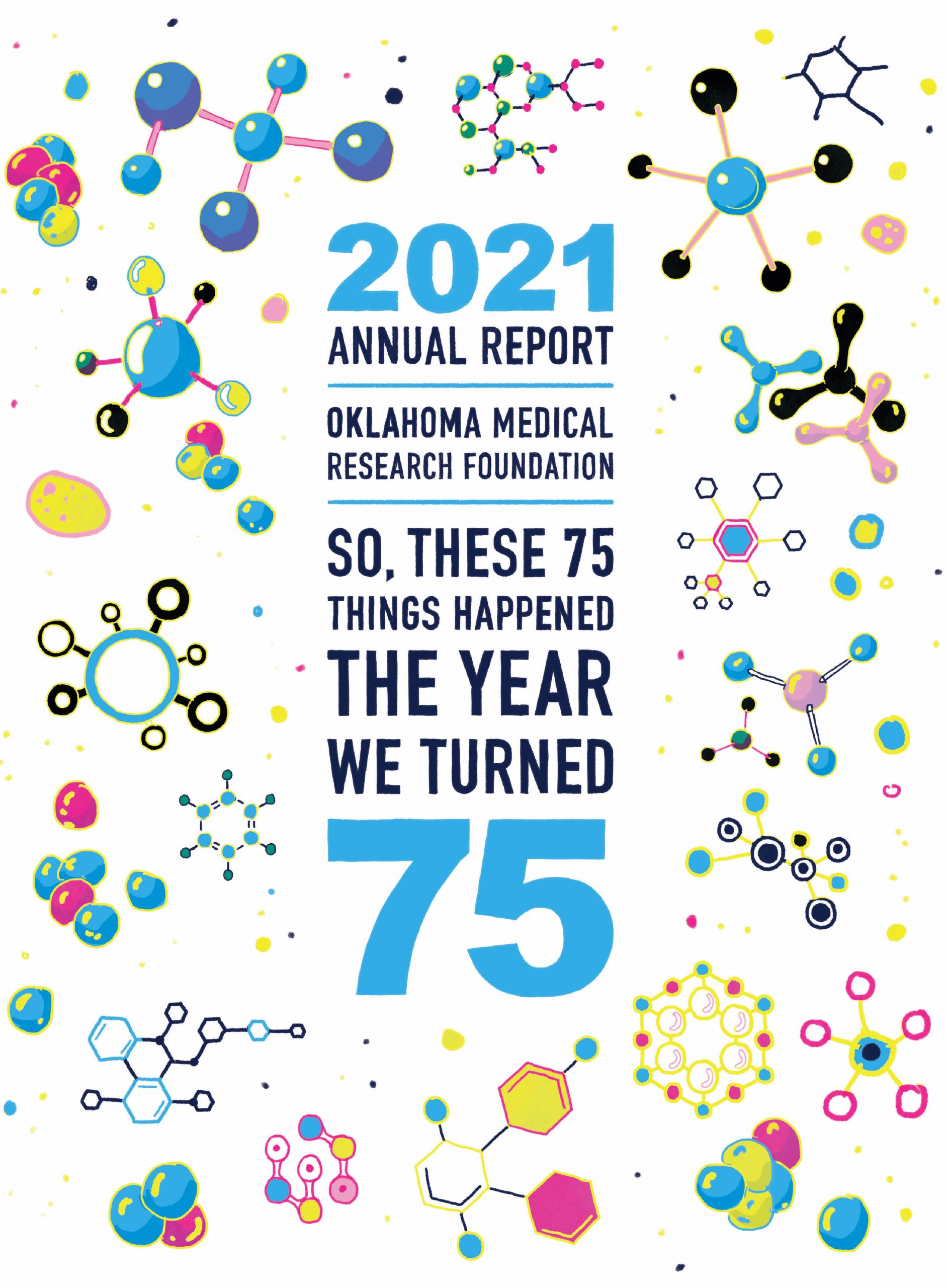

Perhaps the most remarkable thing about Aug. 28, 2021, at OMRF was that it wasn’t remarkable at all.
It was a Saturday, so foundation clinics were closed. But technicians, lab managers, graduate students and scientists still populated OMRF’s labs. And they did what they and their forebears have done since OMRF opened its doors: performed experiments, crunched data, wrote up results for scientific journals and prepared grant proposals.
We can’t know what business and civic leaders who gathered at Oklahoma’s Capitol on that date 75 years earlier would think if they hopped forward in time to witness this scene. That long-ago group came to Northeast 23rd Street to sign the charter of a medical research institute, one of only a handful of such organizations then in existence. They assigned the new nonprofit, which they named the Oklahoma Medical Research Foundation, the mission of “conducting scientific investigations in medicine.”
Their goal sounded simple enough. Still, building and sustaining an institution that has done this for three-quarters of a century has proven anything but.
Happily, OMRF is now one of the nation’s oldest and most respected independent biomedical research institutes. Led by internationally acclaimed immunologists, cardiovascular biologists, and aging and metabolism researchers, the foundation’s labs have given birth to insights and discoveries that helped deepen our understanding and change the therapeutic landscape for patients with conditions ranging from lupus and sickle cell disease to HIV/AIDS.
With our scientific and financial footing now well established, OMRF has realized one of the visions of its founders: establishing a world-class research institute in Oklahoma. They wouldn’t recognize the cutting-edge techniques our scientists use today, things like DNA sequencing, cell sorting and bioinformatics. But as headlines and our pandemic-altered lives reminded us throughout 2021, the dream they had in 1946 remains just as relevant today.
Illustration: @czillustration @levycreative


Dr. Magdalena Bieniasz discovered a targeted therapy that could improve long-term outcomes for ovarian cancer. In experiments, the investigational compound, called AD80, proved more effective than chemotherapy in shrinking ovarian cancer tumor samples taken from both humans and mice. The compound also helped stop tumor metastasis and cancer recurrence. The next step will be to tailor and adapt AD80 into a precision therapy for certain forms of the disease. “This treatment is designed in a way to target only the cancer cells, but not healthy cells,” says Bieniasz. “Ovarian cancer is the fifth-leading cause of cancer deaths among American women and sorely needs better options. This is potentially a huge step in the right direction.”


The National Institutes of Health named OMRF one of the lead sites for a nationwide Covid-19 vaccine clinical trial. The study assessed the antibody response to booster shots in people with autoimmune diseases who didn’t mount strong immune responses to initial vaccination. “We’re concerned about people with autoimmune conditions because they are more likely to have breakthrough episodes of Covid even when fully vaccinated,” says OMRF Vice President of Clinical Affairs Dr. Judith James, who led the trial at OMRF. The study examined whether giving volunteers a booster while also pausing other medications where possible would elicit a stronger antibody response without flaring their underlying disease. With 600 participants at more than a dozen sites nationwide, the trial enrolled people with conditions that include multiple sclerosis, rheumatoid arthritis and lupus. James anticipates she and her colleagues will publish the study’s first results in 2022.
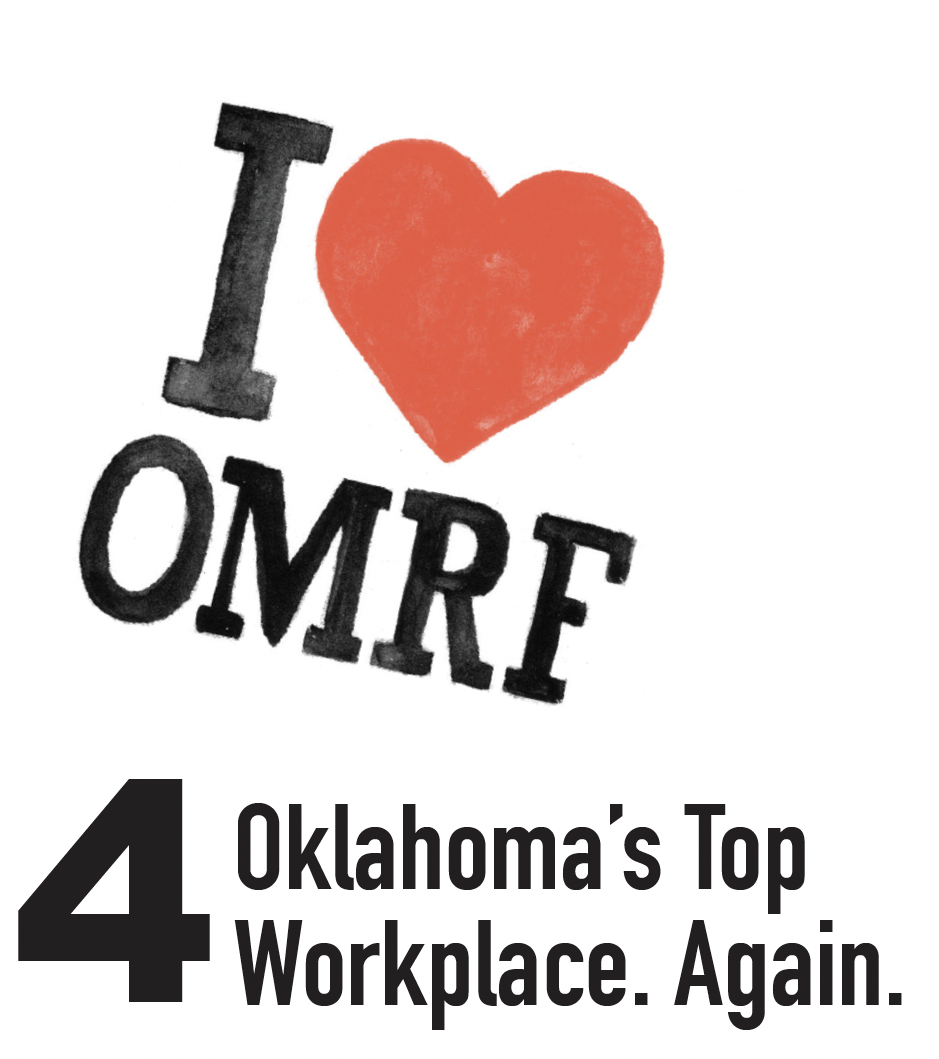
For the third time in five years, The Oklahoman newspaper named OMRF as the state’s Top Workplace. OMRF placed first among large employers (350+ employees) in the competition, which is based on surveys from Energage, a research and consulting firm that conducted statewide polls in which employees responded anonymously to questions about job satisfaction, management quality, pay and benefits, and opportunities for growth. In responses, OMRFers said they enjoy working at the foundation because of cultural and ethnic diversity, the emphasis on work-life balance, the employee-focused response to the Covid-19 pandemic, and the sense that each employee plays a crucial role in fulfilling OMRF’s mission of helping people live longer, healthier lives. Earlier in the year, Energage also recognized OMRF as one of the nation’s best workplaces and presented the foundation with a special award for “meaningfulness,” as OMRF received the highest score of all employers in this category. Toni Snow, a 23-year employee who now serves as an administrative assistant in OMRF’s Multiple Sclerosis Center of Excellence, says she is inspired daily by the “top-notch” research at OMRF. “Every day, I feel like I’m working with the kindest, smartest, most caring people in the world,” she says. “We truly love what we do.”
Illustration: Anna Heigh

In May, OMRF President Dr. Stephen M. Prescott died. He was 73 and had lived with cancer since 2017. During his tenure at OMRF, the physician-researcher orchestrated the largest campus expansion in the foundation’s history and raised $100 million to fund the effort. He also recruited dozens of new scientists, and three drugs and a disease management test born at OMRF reached the market. “He led us to another level,” says Vice President of Research Dr. Rod McEver. Until the end, Prescott remained excited about OMRF’s future. “I’ve been lucky enough to help guide this wonderful institution for 15 years,” he said in April, when he announced his retirement. “And nothing makes me happier than knowing the scientists of OMRF will continue the tradition of biomedical excellence long after I’ve gone.”
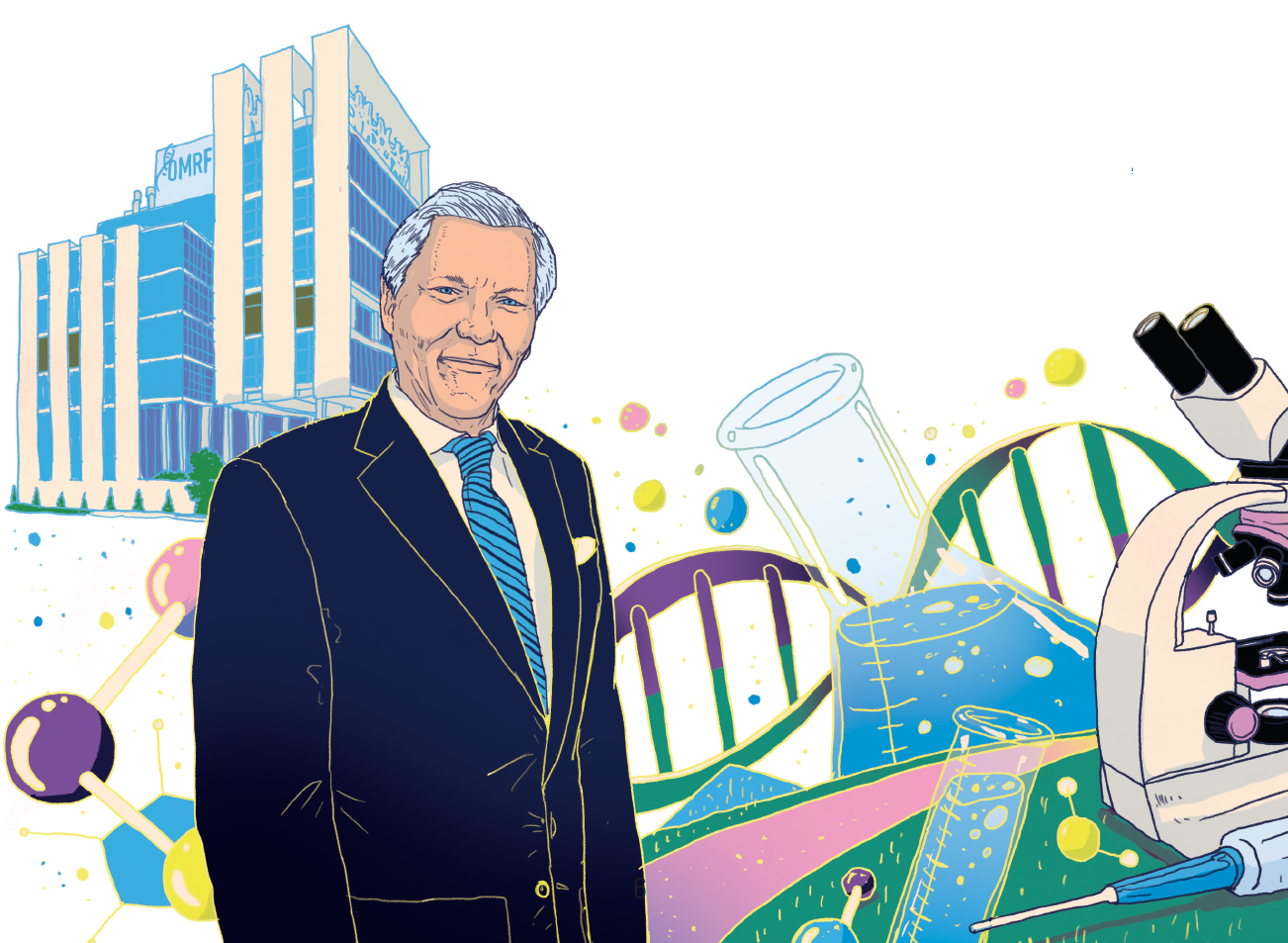

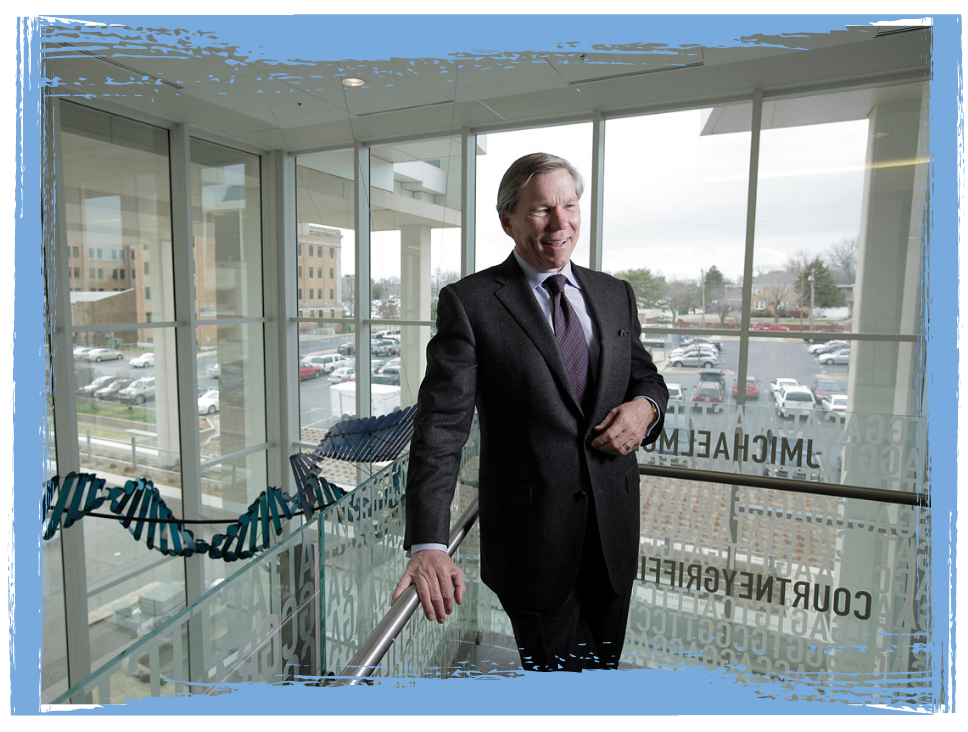
In Prescott’s honor, the Board of Directors established the Stephen M. Prescott Endowment Fund for the Best and Brightest. This perpetual endowment will provide resources to support the recruitment and retention of scientists, a particular passion of Prescott’s. Following a $3 million challenge grant from the J.A. Chapman and Leta M. Chapman Charitable Trust, a campaign led by co-chairs Judy Hatfield and Len Cason raised another $7.3 million in gifts and pledges, exceeding the target of $7 million needed to meet the challenge grant. Lead gifts came from the E.L. and Thelma Gaylord Foundation, George Records, the Anne and Henry Zarrow Foundation, and Dr. Rod and Gigi McEver, with dozens of others also contributing. “This level of support was tremendous, but it wasn’t surprising. It’s just a measure of the love and respect that so many in this community have for Dr. Prescott,” says Hatfield. The fund will be part of the foundation’s permanent endowment, where it will be invested alongside other savings. Each year, OMRF will use the proceeds to ensure it builds and maintains a staff of top-flight researchers. This fund can also enable OMRF to pivot to new research areas when necessary. “Science,” said Prescott in 2016, “changes quickly. The most successful organizations do, too.”


Following Prescott’s death, the Board of Directors appointed Adam Cohen interim president. OMRF’s longtime senior vice president and general counsel, Cohen shepherded the foundation for the remainder of the year while also assisting the Board in conducting a nationwide search for a permanent successor for Prescott. That process, which included extensive outreach in the scientific community and publicizing the opportunity through leading scientific journals and research societies, generated almost 100 nominations and meetings with dozens of prominent researchers across the country. A search committee narrowed the field to a half-dozen semifinalists and, ultimately, a pair of finalists, both of whom came to Oklahoma City in September for extensive in-person interviews and meetings.

In October, OMRF named Dr. Andrew S. Weyrich as OMRF’s next president, with his tenure officially beginning in January 2022. The vice president for research at the University of Utah since 2016, Weyrich is also an internationally recognized leader in blood clotting research. His laboratory and administrative experience, says OMRF Vice President of Research Dr. Rod McEver, gives Weyrich a “keen understanding” of the importance of biomedical research and the challenges it will face in the future. “He will inspire scientists and staff at OMRF, and he will work effectively with community leaders to enhance biomedical research in Oklahoma.” In Utah, Weyrich’s discoveries facilitated key advances in the field of hematology, and he oversaw a research portfolio that totaled more than $600 million annually. Beginning in the 1990s, he’d collaborated with McEver on a series of research projects and admired OMRF from afar, but a visit this past fall with his wife, Amy, to the foundation sealed the deal. “When I came to Oklahoma, I was overwhelmed by the outpouring of support for OMRF,” says Weyrich. “To lead the institution is a once-in-a-lifetime opportunity, and I couldn’t be more excited to get started.”


In partnership with the University of Oklahoma Health Sciences Center and the Oklahoma City Veterans Affairs Medical Center, OMRF successfully renewed its five-year Nathan Shock Center of Excellence in the Basic Biology of Aging grant. Funded by the National Institute on Aging, it’s one of only eight Shock Centers in the nation. With this grant, researchers will continue a broad spectrum of research projects on the process of aging and the role it plays in numerous conditions. Dr. Holly Van Remmen, co-director of the Shock Center, focuses on sarcopenia, which causes a loss of muscle mass and function as we age. While not life-threatening, muscle loss strikes everyone as we grow older and significantly decreases our quality of life. “The goal of our research,” says Van Remmen, “is not to find a fountain of youth but to address the declining quality of life as we age.” Ultimately, she envisions breakthroughs that will allow our “healthspans” to match our lifespans.

When the U.S. Food and Drug Administration gave the green light to Adakveo in late 2019, it marked a major milestone: the first drug ever approved to treat pain crises in sickle cell disease. But only months later came the Covid-19 pandemic. In 2021, as health care edged backed toward normalcy, this medication born at OMRF began impacting patients around the globe. By year’s end, regulators had okayed the drug in 44 countries, and use by hematologists had skyrocketed, more than doubling 2020 levels. Based on discoveries made by OMRF’s Dr. Rod McEver, the medication meets an enormous need: It provides relief from a painful and often life-threatening condition that afflicts approximately 100,000 Americans and 5 million people worldwide. The illness primarily strikes those of African descent. For Danielle Jamison, who lives with sickle cell disease, the drug has changed her life. “I’m not in and out of the hospital, going through the ups and downs of sickle cell so much,” says the 37-year-old mother. Thanks to ongoing treatment with Adakveo, she says, “I’m able to be much more active and have less pain. It’s such a blessing.”



Len Cason thought he was signing on for a one-year term when OMRF’s Board of Directors elected him as Chair in 2001. Two decades later, he marked the anniversary of that moment by getting reelected. For the 20th straight time. “You just don’t see this continuity of leadership on nonprofit boards,” says Bruce Benbrook, who heads the Governance Committee of OMRF’s Board and renominated Cason this past autumn. “And the fact that he keeps getting reelected, with unanimous support, speaks volumes about what kind of leader he is.” Under Cason’s guidance, the foundation’s operating budget has more than doubled, and the endowment has quadrupled. “OMRF has become an iconic institutional presence in our community and state,” says retired Oklahoma Supreme Court Justice Steven Taylor, who’s served with Cason as an OMRF Director since 1991. “A lot of that has to do with what I’d call Len’s inviting leadership style. He has created an atmosphere where people want to be involved with OMRF.”


OMRF finished the fiscal year with a budget surplus, thanks to revenues from fundraising, research grants and technology licensing that outperformed expectations, along with lower-than-anticipated administrative costs. That surplus went into a designated endowment fund, where the Investment Committee of OMRF’s Board will manage the funds and use proceeds to help finance operations in future years.
Illustration: Anna Heigh


The year also saw 100% giving from OMRF’s Board. All 62 Directors donated, giving a total of $854,908. Board giving proves crucial when OMRF applies for charitable support, as many philanthropies require a showing that all Board members have donated. Still, Board Chair Len Cason sees a more fundamental driver. “We all serve on the Board because we believe in OMRF’s mission. That makes giving a no-brainer.”
Illustration: Anna Heigh

Dr. Hal Scofield found that in people with obesity, eating a little more than an ounce of freeze-dried strawberry powder mixed with water (the equivalent of about 2.5 cups of fresh strawberries) each day lowered their blood glucose, improved good lipids and reduced LDL cholesterol, all factors for heart attack and stroke. Study participants also showed improved insulin resistance, an underlying cause of Type 2 diabetes. Like the omega-3 fatty acids in fish, the natural compounds in strawberries appear to be most beneficial when consumed as food rather than as dietary supplements. “We know that eating fish has more health benefits than taking fish oil pills. This appears to be the same for strawberries,” says Scofield, noting that freeze-dried berries retain the same nutrients as fresh ones. “We aren’t certain why, but it supports the idea that eating real, whole foods is important.”
Illustration: Anna Heigh


An existing medication for drug overdose may have a second life-saving benefit: as a treatment for the most common heart valve disease, a study led by an OMRF scientist found. If confirmed in a clinical trial, the discovery by Dr. Jasim Ahamed could have worldwide ramifications for aortic stenosis, a potentially fatal heart condition caused primarily by age and exacerbated by a high-fat diet. According to the American Heart Association, it affects more than 20% of older Americans.

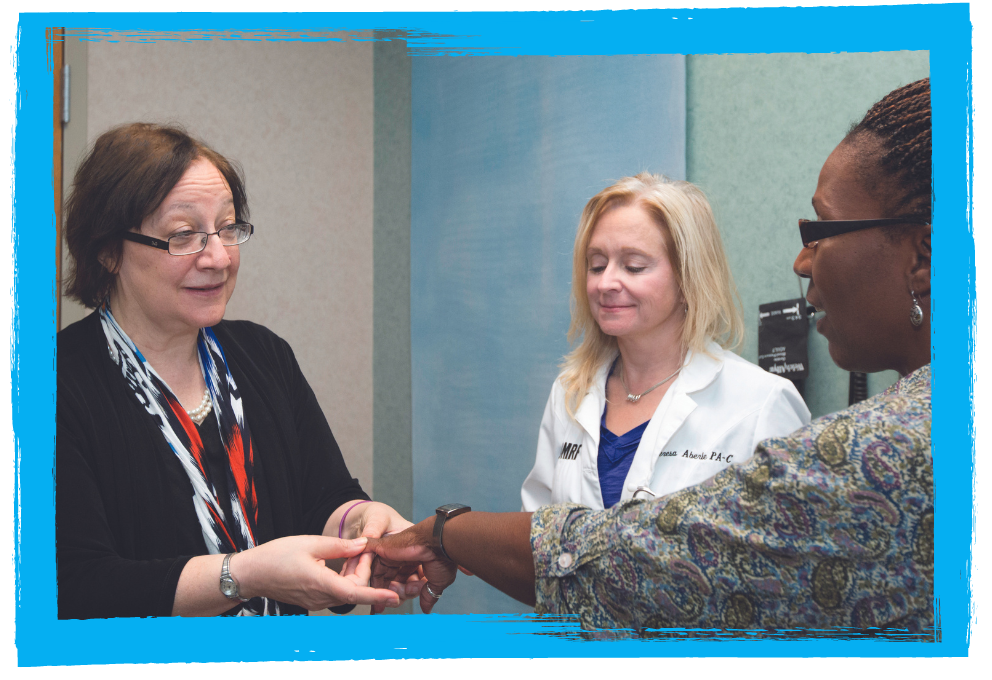 The Lupus Foundation of America awarded Dr. Joan Merrill its 2021 Evelyn V. Hess Award. The honor recognizes Merrill’s exceptional contributions to the field during her nearly 30 years as a lupus physician and researcher. She joined OMRF from the faculty of Columbia University in 2001 to establish a clinical trial laboratory to better understand lupus and work on ways to test drugs for the disease. Since then, she’s built a research cohort of hundreds of patient volunteers, led numerous clinical trials for investigational lupus treatments, and pioneered novel trial designs to test therapies for lupus and other autoimmune illnesses. “Dr. Merrill has an unwavering commitment to improving approaches to lupus research and clinical trials,” says LFA President and CEO Stevan W. Gibson. Her accomplishments, he says, “have and will continue to impact the future of lupus science and the discovery of safer and more effective treatments.” Merrill’s current research looks at the impact of lupus therapies on the immune system and vaccine response and effectiveness in lupus patients. She also continues to study how to better design and implement clinical trials to accelerate the development and approval of new lupus medications.
The Lupus Foundation of America awarded Dr. Joan Merrill its 2021 Evelyn V. Hess Award. The honor recognizes Merrill’s exceptional contributions to the field during her nearly 30 years as a lupus physician and researcher. She joined OMRF from the faculty of Columbia University in 2001 to establish a clinical trial laboratory to better understand lupus and work on ways to test drugs for the disease. Since then, she’s built a research cohort of hundreds of patient volunteers, led numerous clinical trials for investigational lupus treatments, and pioneered novel trial designs to test therapies for lupus and other autoimmune illnesses. “Dr. Merrill has an unwavering commitment to improving approaches to lupus research and clinical trials,” says LFA President and CEO Stevan W. Gibson. Her accomplishments, he says, “have and will continue to impact the future of lupus science and the discovery of safer and more effective treatments.” Merrill’s current research looks at the impact of lupus therapies on the immune system and vaccine response and effectiveness in lupus patients. She also continues to study how to better design and implement clinical trials to accelerate the development and approval of new lupus medications.


A 2021 analysis published in the journal Environmental Research and Public Health found OMRF leads the country in research productivity on systemic lupus erythematosus, the most common form of lupus. Over the past half-century, the foundation has contributed more research papers on the disease than any other institution in the U.S.: Nearly 10% of all lupus studies have a foothold at OMRF.


Kevin Nguyen’s eyes light up when he talks about research. During both his junior and senior years of high school, the Oklahoma School of Science and Mathematics student investigated a gene linked to cancer and birth defects under the mentorship of OMRF’s Dr. Dean Dawson. Using the Nobel Prize-winning gene-editing tool CRISPR, Nguyen introduced mutations to deactivate a particular gene and then used imaging technologies to observe how switching off the gene impacts the movement of chromosomes. “I came in thinking, ‘I’m just a high school student.’ But the lab is really collaborative, and they made me feel like a colleague,” says Nguyen, the son of immigrants who own small businesses in Oklahoma City. After graduating from OSSM in May, he’s now studying biomedical engineering at Johns Hopkins University. Medical school is in his sights and someday, perhaps, a career as a physician-researcher in Oklahoma.
Illustration: Brian Taylor

Dr. Mike Beckstead received a grant from the National Institute on Aging to investigate a possible connection between Alzheimer’s disease and dopamine, a chemical responsible for voluntary movement and the perception of reward in the brain. Beckstead studies what can happen when things go wrong with dopamine neurons, ranging from Parkinson’s disease (too little) to drug addiction (too much). “Although dopamine has never been studied in context with Alzheimer’s, we have a lot of evidence to suggest that it’s involved, especially in the initial stages of disease,” says Beckstead, who joined OMRF in 2017 from the University of Texas Health Science Center at San Antonio.
Illustration: Anna Heigh


Stillwater High School students presented OMRF with a check for nearly $12,000 to support cancer research. Since 2011, Stillwater High has designated OMRF as the charitable beneficiary of the school’s annual “Pink Out” activities. But the usual week of special events didn’t occur due to Covid-19. Instead, students worked with local businesses to launch online sales for themed T-shirts, coordinated curbside pickup donations for restaurant patrons, and made direct appeals to Stillwater-area residents. The latest gift brings Stillwater High’s total giving to OMRF over the past decade to $89,000.
Illustration: Anna Heigh
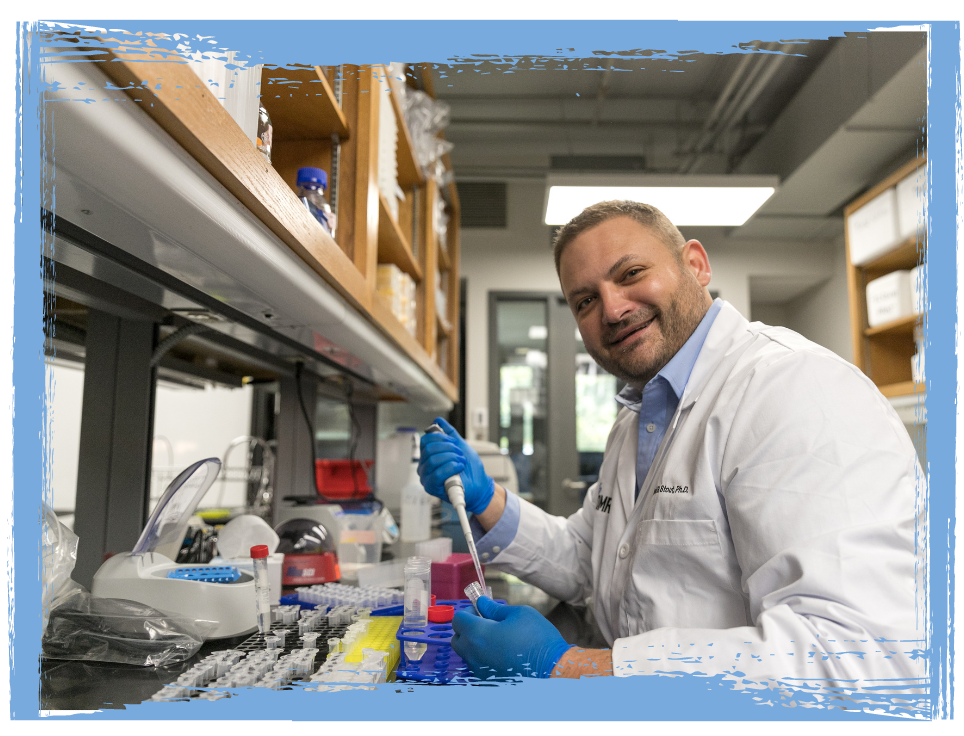

Only months after he joined OMRF, Dr. Michael Stout received a five-year, $2.57 million grant from the National Institutes of Health to study the impact of sex hormones and their receptors on conditions like Type 2 diabetes and chronic liver disease. Along with another grant he brought with him from the University of Oklahoma Health Sciences Center, where he was a faculty member, this new award will enable Stout to probe new approaches to fight age-related illnesses. “Understanding the differences in how males and females age is a critical barrier to developing sex-specific treatments,” he says. “This is an important building block in combatting diseases of aging and chronic illness.”

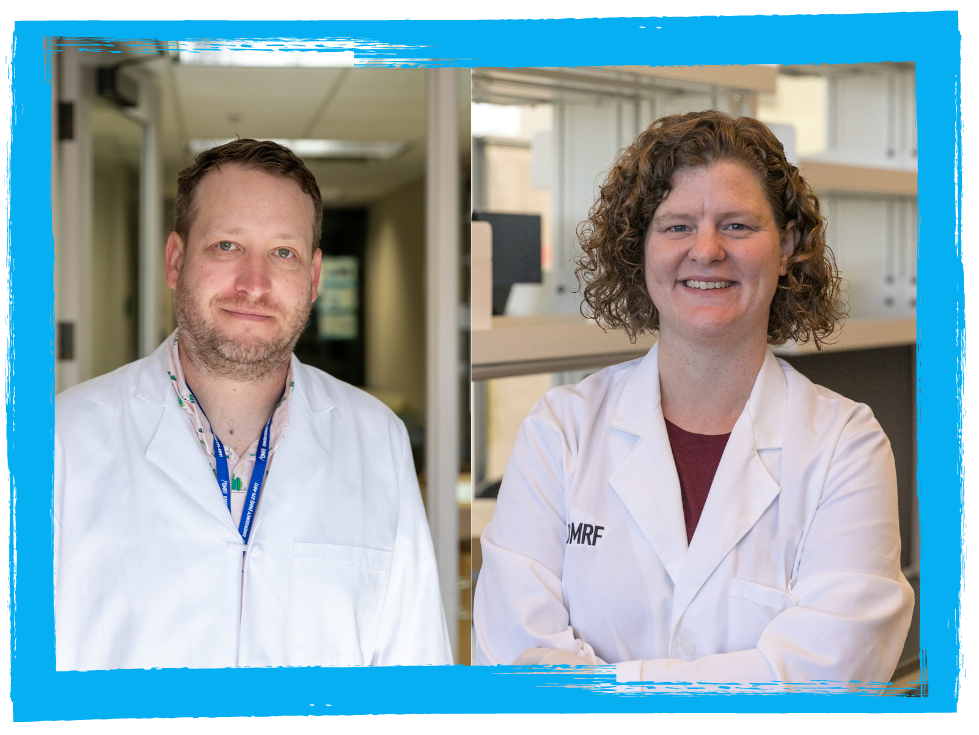
Drs. Audrey Cleuren and Jake Kirkland also joined OMRF in 2021. Both had recently completed postdoctoral fellowships: Cleuren at the University of Michigan, Kirkland at Stanford University. Cleuren focuses her research on endothelial cells, which form the inner lining of blood vessels. Kirkland, a cell biologist, looks at how alterations in certain genes drive cancer.


We’d mapped out an entire year of staff events to celebrate OMRF’s 75th anniversary, but like just about everything else these days, the pandemic pushed pause on those plans. With case numbers improving, we expect to hit the restart button soon. In the meantime, we thanked the people who make the foundation what it is with OMRF swag that included T-shirts, beanies and insulated mugs.

Multiple sclerosis requires attention to the patient as a whole person. And that idea is at the core of OMRF’s Multiple Sclerosis Center of Excellence, which celebrated its 10th anniversary in 2021. For a decade, the center has served as a one-stop shop for people living with the neurodegenerative disease, providing specialized neurological and ophthalmologic care, a dedicated infusion suite, physical therapy, general wellness education and access to clinical trials. With more than 7,000 patient visits each year, the center’s 20-person team stays busy. They’re also devoted to advancing scientific knowledge through clinical and basic research, which provides a deeper understanding of the disease. The goal, says Dr. Gabriel Pardo, the center’s founding director, “is to transform laboratory insights into therapeutic gains for patients.”
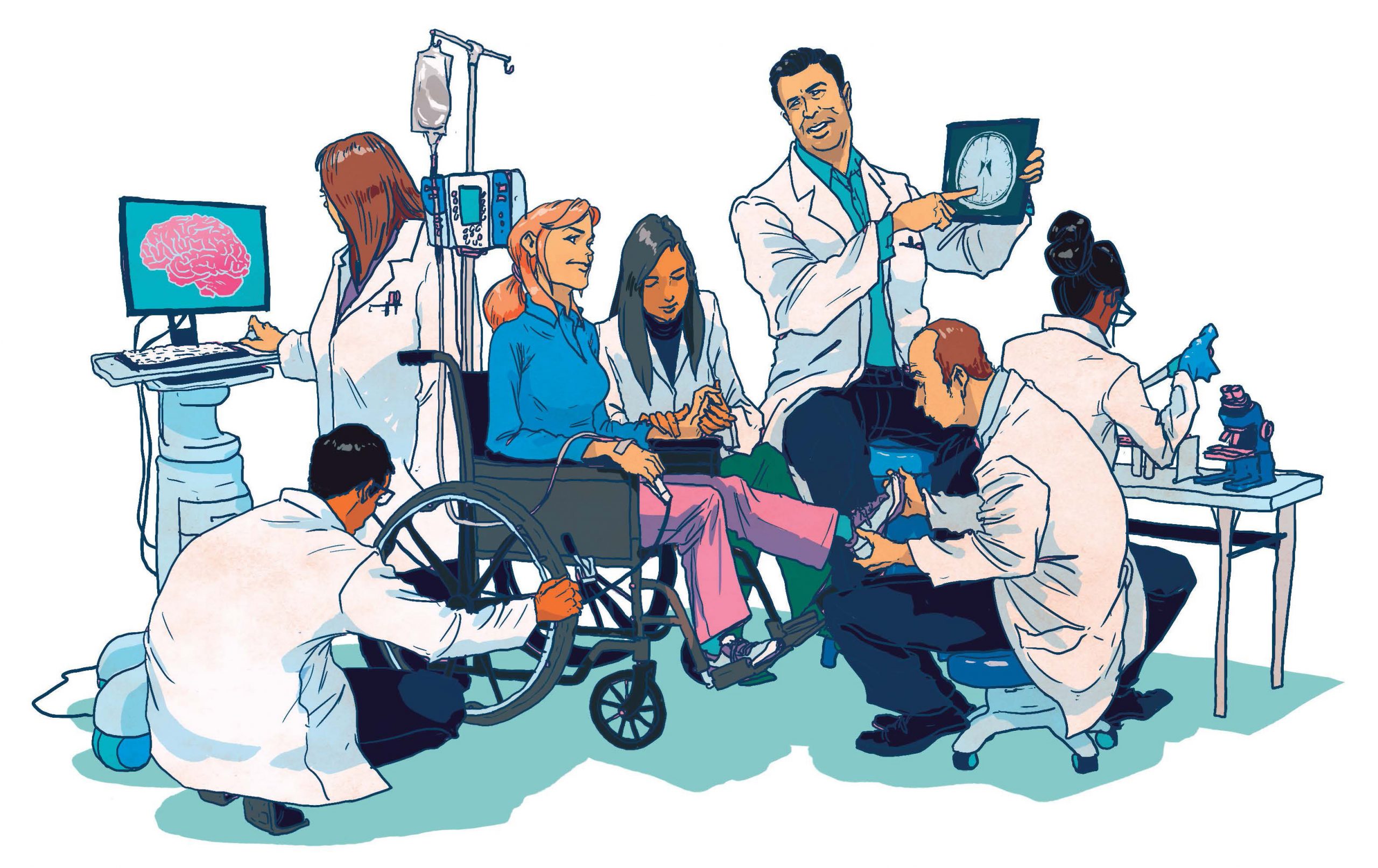
Illustration: @michaelbyers @levycreative


After 45 years, Mike Bailey decided to hang up his OMRF lanyard. Bailey came to OMRF fresh out of the University of Oklahoma, where he’d worked part-time as an undergraduate in the bursar’s office. “I needed a real job, and my boss recommended a place I’d never heard of called OMRF.” The foundation hired the youngster as a grants accountant, and for the next four-plus decades, Bailey served OMRF in many roles. Ultimately, he became the associate vice president for administrative support services, directing purchasing, facility services, biomedical equipment repair, security and food services for the foundation, which now counts almost 500 employees on its six-building campus. “When I started, OMRF only had two buildings. I never could have envisioned what it would become today.” He has many fond memories of his days at OMRF, but one stands out: when he met a “charming and beautiful” coworker named Sherri Smith. She became Sherri Bailey, and the couple – both now retired from OMRF – marked their 40th anniversary in 2021.

In June, OMRF welcomed its inaugural class of Langston Biomedical Research Scholars. A half-dozen undergraduate students from Oklahoma’s only historically Black college or university worked alongside OMRF scientists for eight weeks, studying cardiovascular disease, osteoarthritis, neurodegenerative conditions and autoimmune diseases. But the program is more than a summer job. Following the internship, students could choose to work with OMRF mentors on ongoing research projects, and several are now continuing their projects. “In a typical internship, you might learn a few exciting things, but at the end of the summer, the research project for the student comes to an end,” says Dr. Byron Quinn, chair of Langston’s biology department. “Here, we’ve tried to build something more permanent: long-term relationships between LU students and OMRF mentors that will last years, not months.”
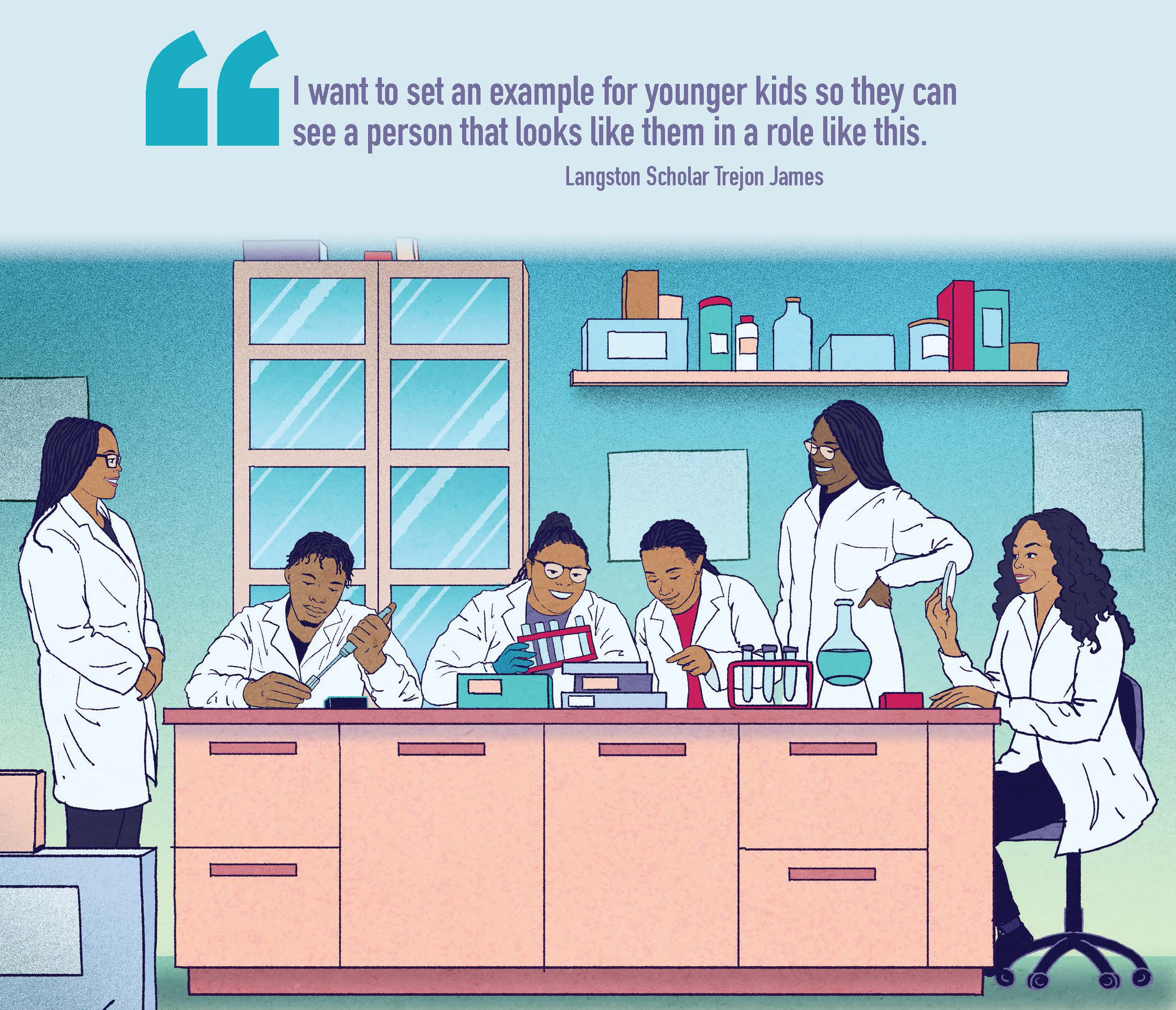
Illustration: @antoinedoreart @levycreative


Vice President and Chief Financial Officer Tim Hassen completed his two-year term as president of the Association of Independent Research Institutes. The association serves as an umbrella organization for approximately 80 nonprofit research organizations, the vast majority of which, like OMRF, focus their efforts on human disease. Collectively, its members receive about $4 billion in annual funding from the National Institutes of Health and have been home to 11 Nobel laureates.


The North American Vascular Biology Organization named OMRF’s Dr. Courtney Griffin as president. NAVBO is an international society of scientists who study the function and diseases of blood vessels. Griffin will lead the organization’s education, outreach and advocacy efforts. “We’re increasingly focused on younger students, and we’re making real progress in increasing involvement with underrepresented groups,” says Griffin. “It’s a joy to build a scientific family that extends around the world and empowers science.”


When vessels grow out of control in our retinas, it results in eye disorders like diabetic retinopathy and the retinopathies found in premature infants. These conditions can lead to vision loss and, finally, blindness. Working with mice, Drs. Courtney Griffin and Chris Schafer discovered a compound that causes diseased retinal vessels to regress and die. This past year, they refined their discovery using funds from OMRF’s Innovation Advancement Program. Through targeted investments in early-stage technologies, says program coordinator Dr. Andrew Westmuckett, “We hope to find partners to transform our research into therapies to help patients.”

In a study involving 35 research centers and hospitals on four continents, OMRF’s Dr. Wan Hee Yoon used fruit flies to uncover the shared genetic roots of seemingly unrelated neurological and developmental issues in nine pediatric patients. Published in the American Journal of Human Genetics, the study involved children who suffered from symptoms including epilepsy, gait problems, an underdeveloped brain, and hearing and sight loss. Using DNA sequencing, researchers found a crucial link among all the patients: “Each had mutations in the same gene,” says Yoon. Using Drosophila, the common fruit fly, Yoon proved the mutations weren’t just a shared trait but the actual cause of their disease. He says this work represents the first step in someday finding a treatment or perhaps even a cure for the condition, which at least for now is known only by reference to the gene in which the mutation is found, OGDHL.
Illustration: Anna Heigh
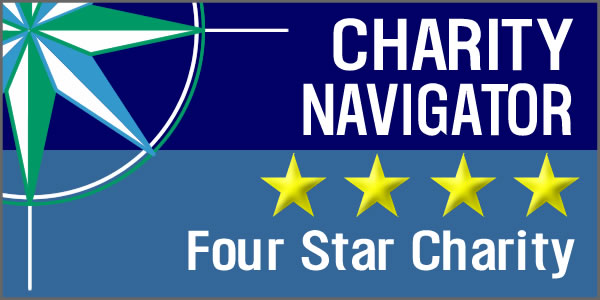

OMRF received the highest possible rating from the nation’s largest charity evaluator. This is the 19th time OMRF has earned the top rating from Charity Navigator, which measures performance in areas such as fundraising, program and administrative expenses, fundraising efficiency, revenue and expense growth, and overall transparency. “The intent of our work is to provide donors with essential information to give them greater confidence in both the charitable decisions that they make and the nonprofit sector,” says Charity Navigator President and CEO Michael Thatcher. “This exceptional designation sets OMRF apart from its peers and demonstrates to the public its trustworthiness.”

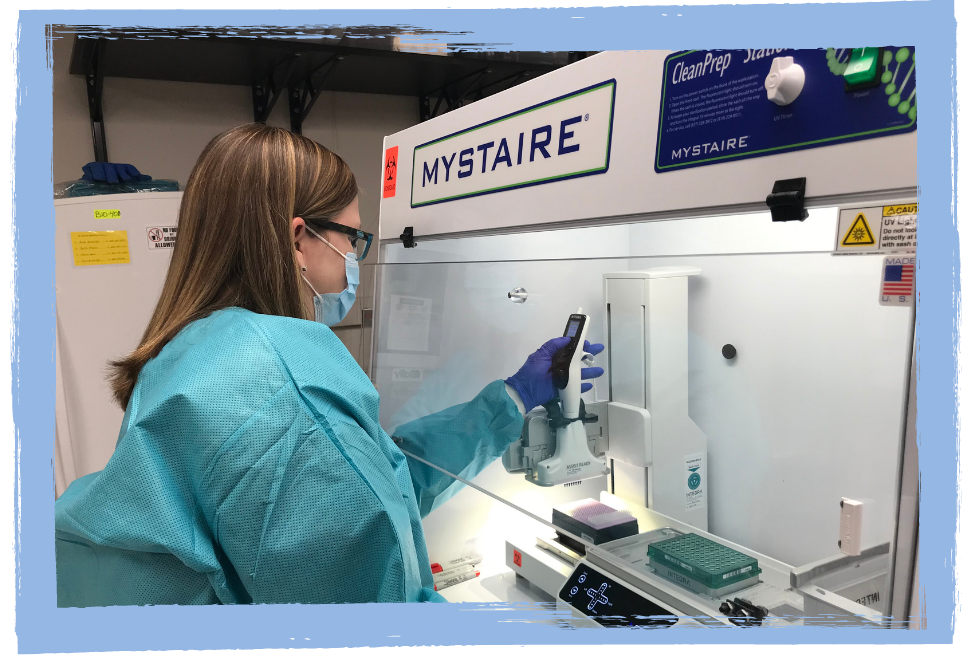 OMRFers began 2021 much the way they finished 2020: with a weekly Covid-19 test. As most foundation employees returned onsite (after all, you can’t do an experiment in a bathtub – or at least not a very good experiment), OMRF sought to protect its staff and prevent viral spread until effective vaccines became available. Dr. Joel Guthridge and his team answered the call, developing a saliva-based PCR test using existing scientific equipment and reagents. “It was pennies on the dollar comparatively,” Guthridge says of the method, which spared employees a nasal swab and required them only to spit in a cup. Most importantly, the weekly program provided peace of mind to the OMRF community during uncertain times, says grants and contracts director Stephanie Mode. “I felt safe coming to work, and I felt protected not only for myself but for my family.” Over seven months, Guthridge and his team ran approximately 10,000 tests. OMRF registered fewer than 20 infections, and there were no instances of onsite spread among employees.
OMRFers began 2021 much the way they finished 2020: with a weekly Covid-19 test. As most foundation employees returned onsite (after all, you can’t do an experiment in a bathtub – or at least not a very good experiment), OMRF sought to protect its staff and prevent viral spread until effective vaccines became available. Dr. Joel Guthridge and his team answered the call, developing a saliva-based PCR test using existing scientific equipment and reagents. “It was pennies on the dollar comparatively,” Guthridge says of the method, which spared employees a nasal swab and required them only to spit in a cup. Most importantly, the weekly program provided peace of mind to the OMRF community during uncertain times, says grants and contracts director Stephanie Mode. “I felt safe coming to work, and I felt protected not only for myself but for my family.” Over seven months, Guthridge and his team ran approximately 10,000 tests. OMRF registered fewer than 20 infections, and there were no instances of onsite spread among employees.

In March and April, OMRF hosted employee vaccine clinics. Those sessions helped push staff vaccination levels above 80% by the spring and enabled the foundation to end weekly testing in May. Come fall, once regulators gave widespread approval for boosters, the foundation held follow-up clinics for staff. By year’s end, 98% of employees were vaccinated.
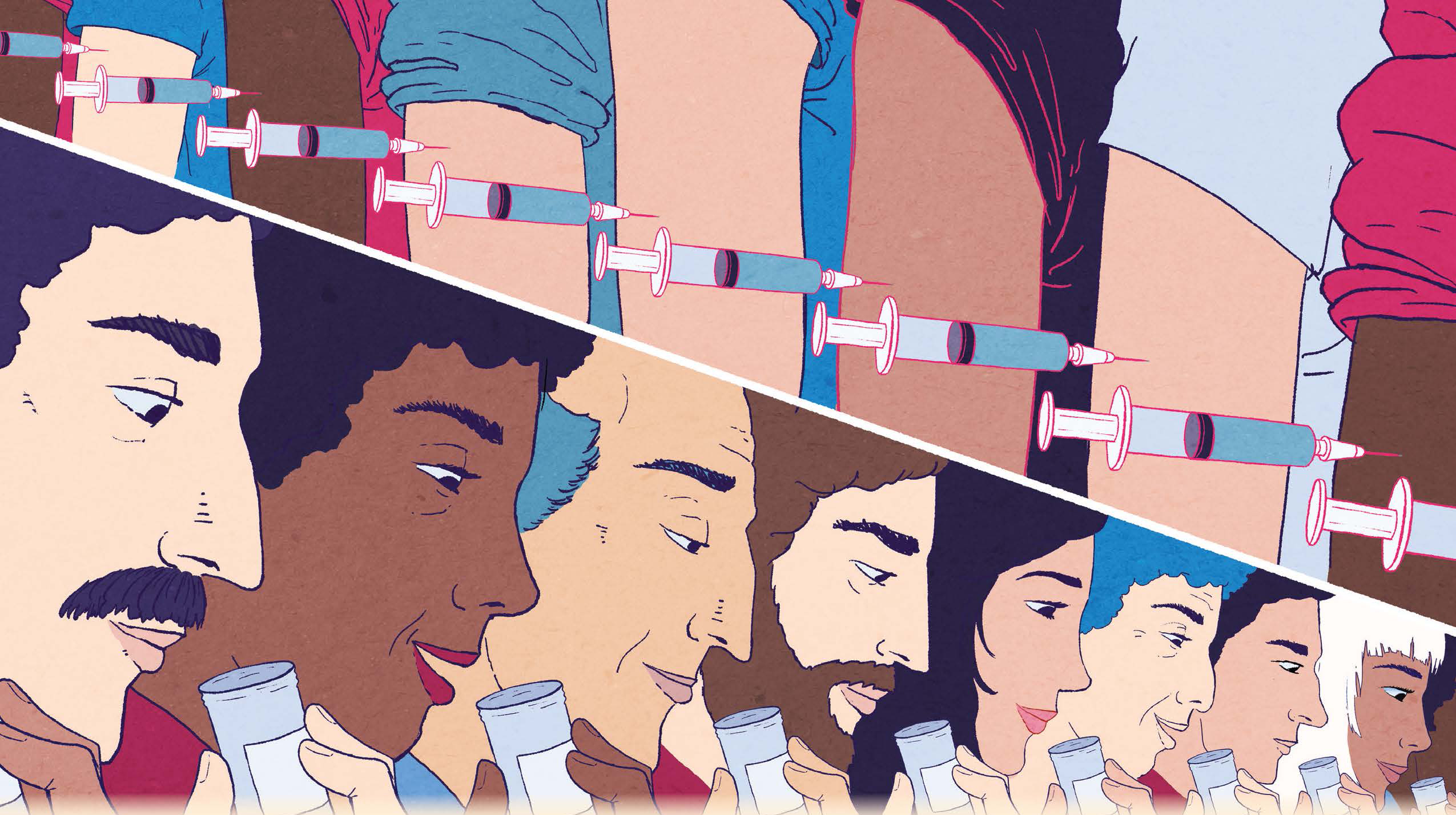
Illustration: @antoinedoreart @levycreative
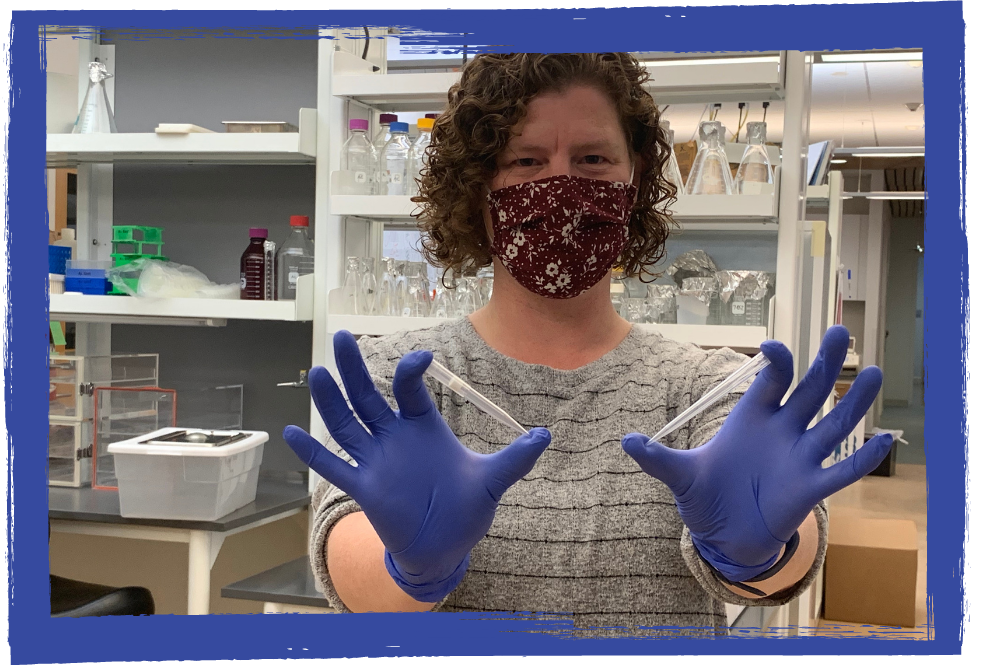

Pandemic-related supply chain issues wreaked havoc on the economy, and biomedical research was not immune. Shortages of equipment and lab supplies proved particularly acute for new researchers, who must start from scratch when establishing their labs. When Dr. Audrey Cleuren joined OMRF in the fall, she discovered that deliveries for a crucial plastic specimen tube were delayed by nearly three months. “We could try to use a different type, but it potentially jeopardizes the results of an experiment.” Instead, she chose to wait. She also had to borrow an older-model centrifuge, a high-speed rotating device used to separate samples, from another scientist; the one she wanted was back-ordered by six months. And problems weren’t restricted to newcomers. “The difficulty in finding critical equipment is as bad as I’ve seen it in my 30 years here,” says Kiely Grundahl, a lab manager at OMRF. As a result, she and her colleagues spend hours hunting down supplies from alternate vendors. If that fails, they look to their OMRF neighbors. “You send out a mass email,” says Mike McDaniel, who manages a lab in OMRF’s Cardiovascular Biology Research Program. “Like, ‘Hey, does anybody have a this or a that they’re not using for the time being to tide us over?’”


With cases – and variants – continuing to circulate throughout 2021, OMRF didn’t quite return to business as usual. Still, a bright spot came in May when OMRF reopened its fitness center, which employees can use free of charge. Full vaccination was required, and like all spaces at OMRF occupied by multiple people, this one continued to require masking. While the extra layer of protection may have added a new dimension to conditioning, it didn’t dampen the enthusiasm of OMRFers eager to get their sweat on. “During the pandemic, I exercised maybe once per week at home,” says Dr. Caleb Marlin. “Now that our gym is open again, I’m back in there nearly every day.”


For the second straight year, the Covid-19 pandemic led to the cancellation of OMRF’s “241” events. Since its inception in 2012, the annual two-events-for-one-great-cause celebration has raised a total of more than $5 million for OMRF. The 2021 iteration was scheduled to feature both a food and wine festival and a musical performance by singer-songwriter Emmylou Harris, who’s won 14 Grammys and is a member of the Country Music Hall of Fame. Pandemic willing, OMRF plans to host the 2022 installment of 241 in October.
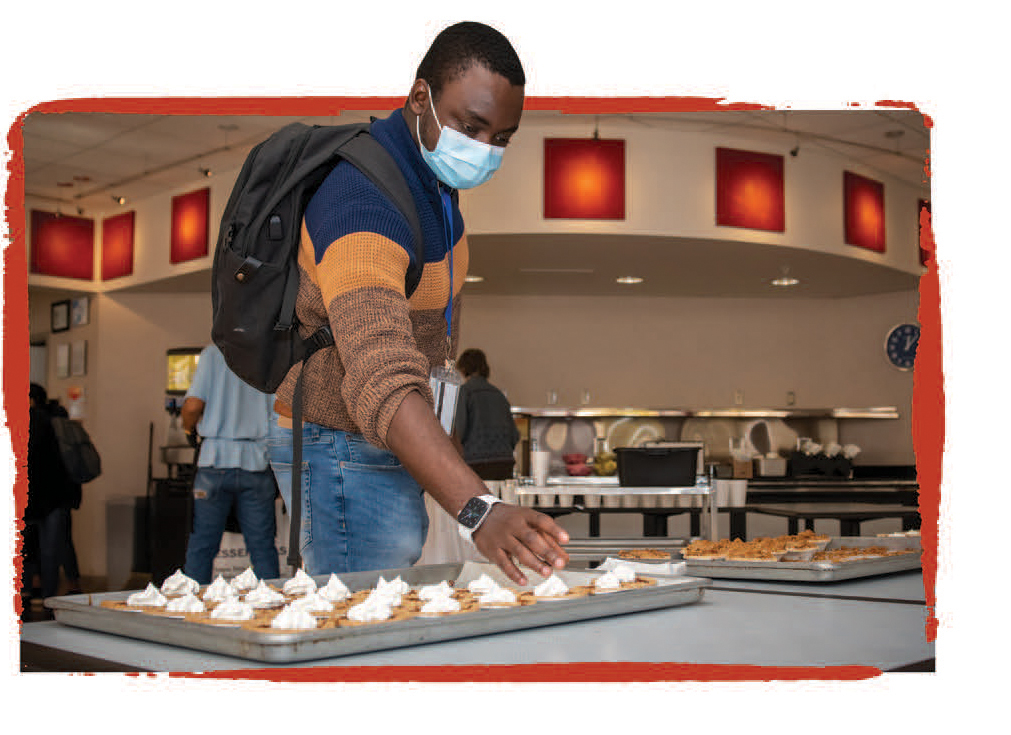

In 2020, the pandemic also put the kibosh on a longtime OMRF tradition: serving a Thanksgiving meal to all employees. (Technically, OMRF’s Research Café staff dished out turkey, stuffing, mashed potatoes, green bean casserole, cranberry sauce and a selection of pies at lunch on the Friday before Thanksgiving, but the to-go meal otherwise lacked the most important marker of the beloved holiday smorgasbord: gathering together.) For 2021, the foundation revived the tradition, but with a Covid-era twist: all meals were takeout. OMRF also underwrote the full cost of the feast. “A free meal may seem like a relatively small thing,” says OMRF Vice President of Human Resources Courtney Greenwood, “but we want to do all we can to say thank you to the people who make OMRF what it is.”

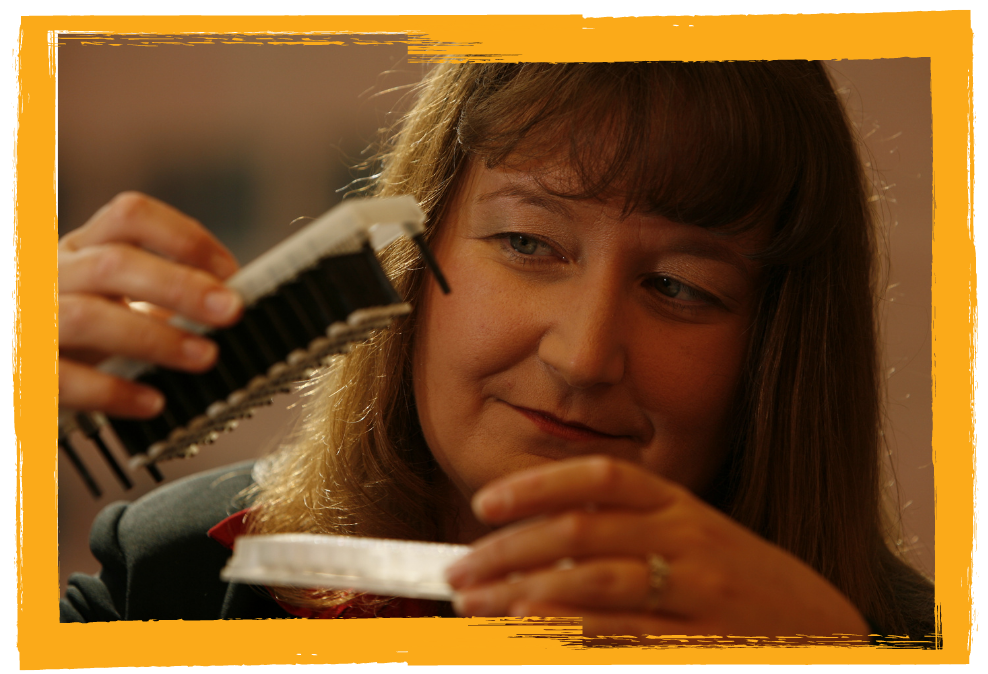
The Association of American Physicians elected Vice President of Clinical Affairs Dr. Judith James as a member. An immunologist and board-certified rheumatologist, James leads OMRF’s Arthritis and Clinical Immunology Research Program. The honor recognizes her excellence in the pursuit of medical knowledge and the advancement of clinical science in her 27 years as a physician-scientist. She’s gained international recognition for her work in predicting and preventing lupus. “Dr. Judith James is one of the most outstanding physician-scientists of her generation,” says University of Colorado Denver Head of Rheumatology Dr. V. Michael Holers, who nominated James for the honor. “She has performed groundbreaking research to help us understand how autoimmune diseases develop and can be treated using innovative new strategies.” James joins seven other Oklahoma physicians, including OMRF Vice President of Research Dr. Rod McEver, as members of the association, which seeks to inspire physician-led research.


Forbes magazine named Dr. Caleb Lareau to its “30 Under 30 in Science” list. As an undergraduate at the University of Tulsa, Lareau spent a summer at OMRF as a Sir Alexander Fleming Scholar. He then continued to work with OMRF’s Dr. Courtney Montgomery while completing his Ph.D. at Harvard Medical School. Now a postdoctoral fellow at Stanford University, he researches the molecular basis of cancer. He co-founded Cartography Biosciences, a startup company developing precision immunotherapies for cancer.


Dr. Wesley Robert “Bob” Mote was soft-spoken and private. A U.S. Air Force physician for 39 years, he still lived in the 1,200-square-foot Moore, Oklahoma, home he purchased in the ‘60s when he died at age 83. Mote, who never married and had no children, made a $75 gift to OMRF in 1989. So, when he died, foundation officials were more than a little surprised to learn of a second gift – worth $2.2 million. Although Mote’s grandnephew Wes Mote was “shocked” to learn the size of his uncle’s estate, he wasn’t surprised by his choice of beneficiary. “He’d been around medicine since the time he was born, so to us, it makes perfect sense that he left his estate to research.” Because Mote didn’t designate his donation to a particular area of science, the gift will fund research at OMRF where it’s needed most.
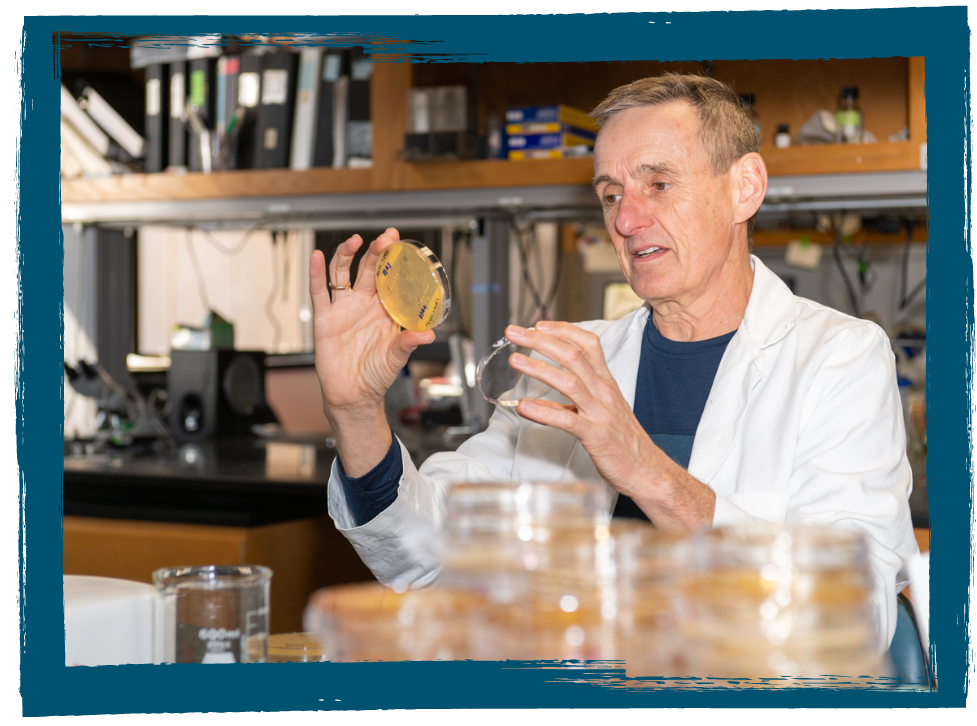

The National Institutes of Health awarded Dr. Dean Dawson a four-year grant to continue his research on the cause of errors in cell division that lead to birth defects. “Most of us inherit a perfect set of 23 chromosomes from each of our parents. But when the wrong number of just one chromosome is inherited, birth defects or issues with pregnancy often result,” says Dawson. Known as aneuploidy, an abnormal number of chromosomes is a leading cause of miscarriage and infertility. It also results in conditions like Down syndrome, Turner syndrome and Klinefelter syndrome. An estimated 1 in 150 babies is born with a chromosomal condition. By understanding the cellular machinery that moves chromosomes in healthy cells, Dawson aims to uncover how mistakes happen in the reproductive process and, down the line, intervene in order to prevent them. “The discoveries we’re after are the kind that change textbooks.”

In a new study, Dr. Tim Griffin’s lab looked at how diet and exercise affect the knee joints of mice. The scientists zeroed in on synovial fluid, the liquid that cushions the ends of bones and reduces friction as joints move. The OMRF researchers found that synovial fluid from obese mice that exercised modestly resembled the fluid in lean mice, even though the obese rodents continued eating a high-fat diet and didn’t lose weight. “What that tells us is that losing weight isn’t a requirement for having beneficial changes in the joint,” Griffin says.

Illustration: Taylor Callery
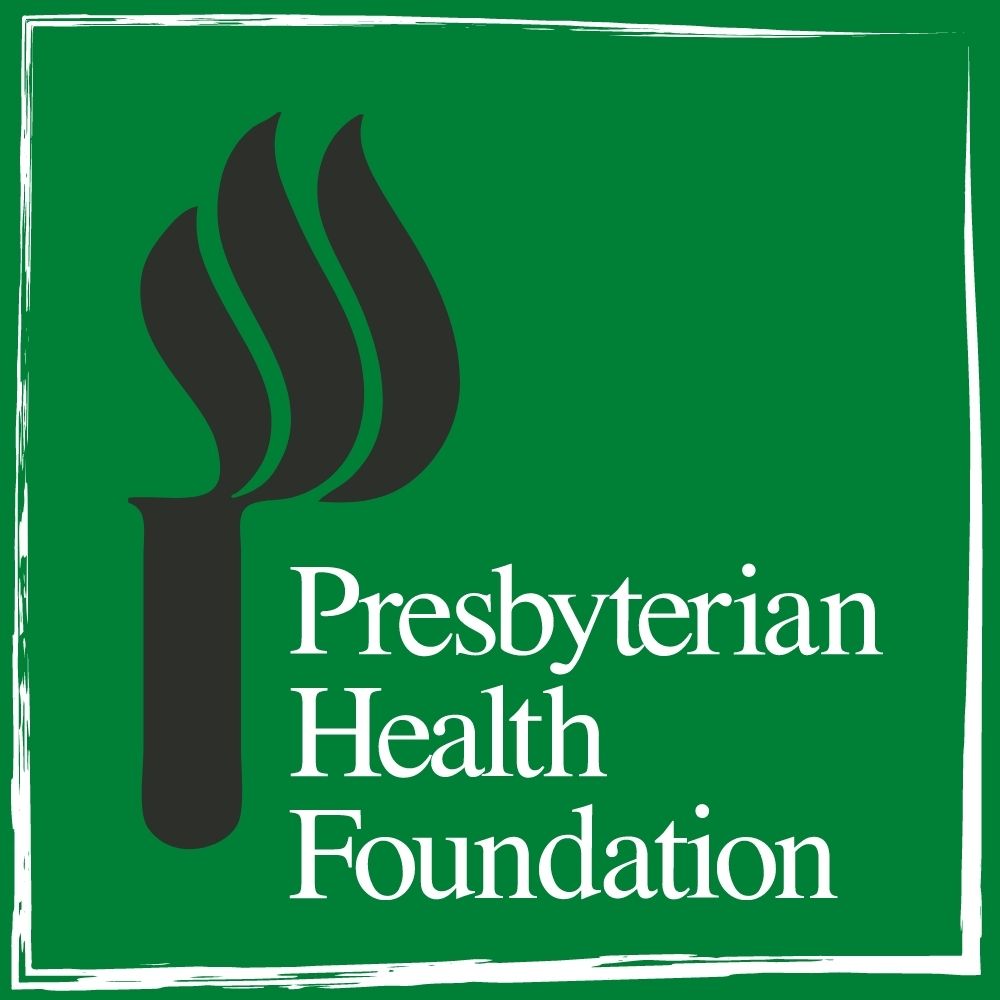

Since its inception, the Presbyterian Health Foundation has focused on supporting medical research in Oklahoma City. In 2021, it awarded $7.7 million in grants to more than 80 research projects at OMRF and the University of Oklahoma Health Sciences Center to study diseases ranging from cancer to Covid-19. “Inspiring health innovation is the focus of our mission, and we’re proud to support this critical work,” says PHF President Rick McCune.


With translucent bodies the size of paper clips, zebrafish might look like they belong in an aquarium at a pet store or in a school classroom. But for Dr. Gaurav Varshney, they represent the key to understanding human disease. The tiny fish share 70% of our genetic code, and by introducing gene mutations that correspond to ones known to cause disease risks in humans, the OMRF researcher investigates the origins of conditions that include sleep disorders, cardiovascular disease, eye diseases, obesity and skin pigmentation abnormalities. In 2021, Varshney and a colleague from Stanford University received a four-year grant from the National Institutes of Health to continue that work.
Illustration: Anna Heigh


When Roosevelt Mask joined OMRF in 1987, he knew he’d found a home. “I was a little bit hot-headed when I started, and I met a great group of people who really helped calm me down,” he said in a 2018 interview with OMRF’s employee newsletter. For more than three decades, he was a fixture on OMRF’s receiving dock, where he worked as a senior materials handler. But Mask’s day didn’t come to an end at 5 o’clock, as he also worked as a night engineer, keeping the premises safe and secure. “I’m usually here from 7:30 a.m. to 11 p.m.,” he said. “This is like my second home.” Mask prided himself on his skills as a chili chef, which typically earned him the top prize at OMRF’s annual chili cook-off. After 33 years at the foundation, he retired in 2020. “I’ve liked everything about this place, especially the people,” he said. Mask passed away on Sept. 26, 2021. He was 71.




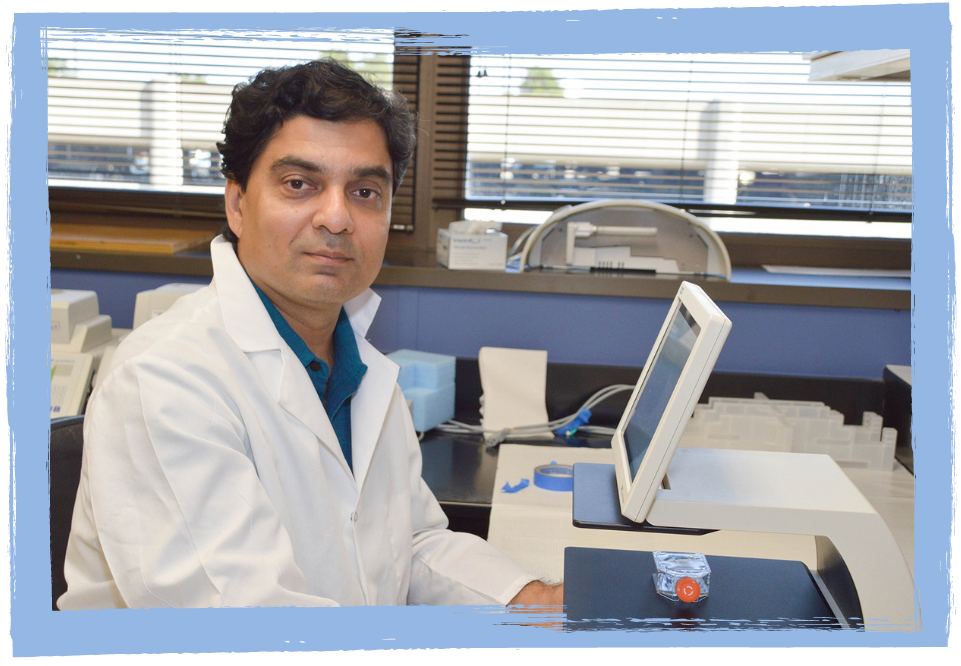
 Dr. Umesh Deshmukh received a grant from the National Institutes of Health to study how viral infections such as Covid-19 can influence the development of autoimmune conditions. Specifically, he’ll investigate how a hyperactivated immune system’s attacks on salivary glands may ultimately lead to an illness known as Sjögren’s disease. “We are learning more every day about the long-term side effects of SARS-CoV-2 infection, and specifically, we have learned the virus has found a niche in the salivary glands”, Deshmukh says. In Sjögren’s, immune cells attack moisture-producing glands, leading to painful dryness and decreased ability to produce tears or saliva. The condition affects up to 4 million Americans. Deshmukh’s experiments will focus on how Covid-19 activates genes and immune factors that can put people at risk for Sjögren’s.
Dr. Umesh Deshmukh received a grant from the National Institutes of Health to study how viral infections such as Covid-19 can influence the development of autoimmune conditions. Specifically, he’ll investigate how a hyperactivated immune system’s attacks on salivary glands may ultimately lead to an illness known as Sjögren’s disease. “We are learning more every day about the long-term side effects of SARS-CoV-2 infection, and specifically, we have learned the virus has found a niche in the salivary glands”, Deshmukh says. In Sjögren’s, immune cells attack moisture-producing glands, leading to painful dryness and decreased ability to produce tears or saliva. The condition affects up to 4 million Americans. Deshmukh’s experiments will focus on how Covid-19 activates genes and immune factors that can put people at risk for Sjögren’s.
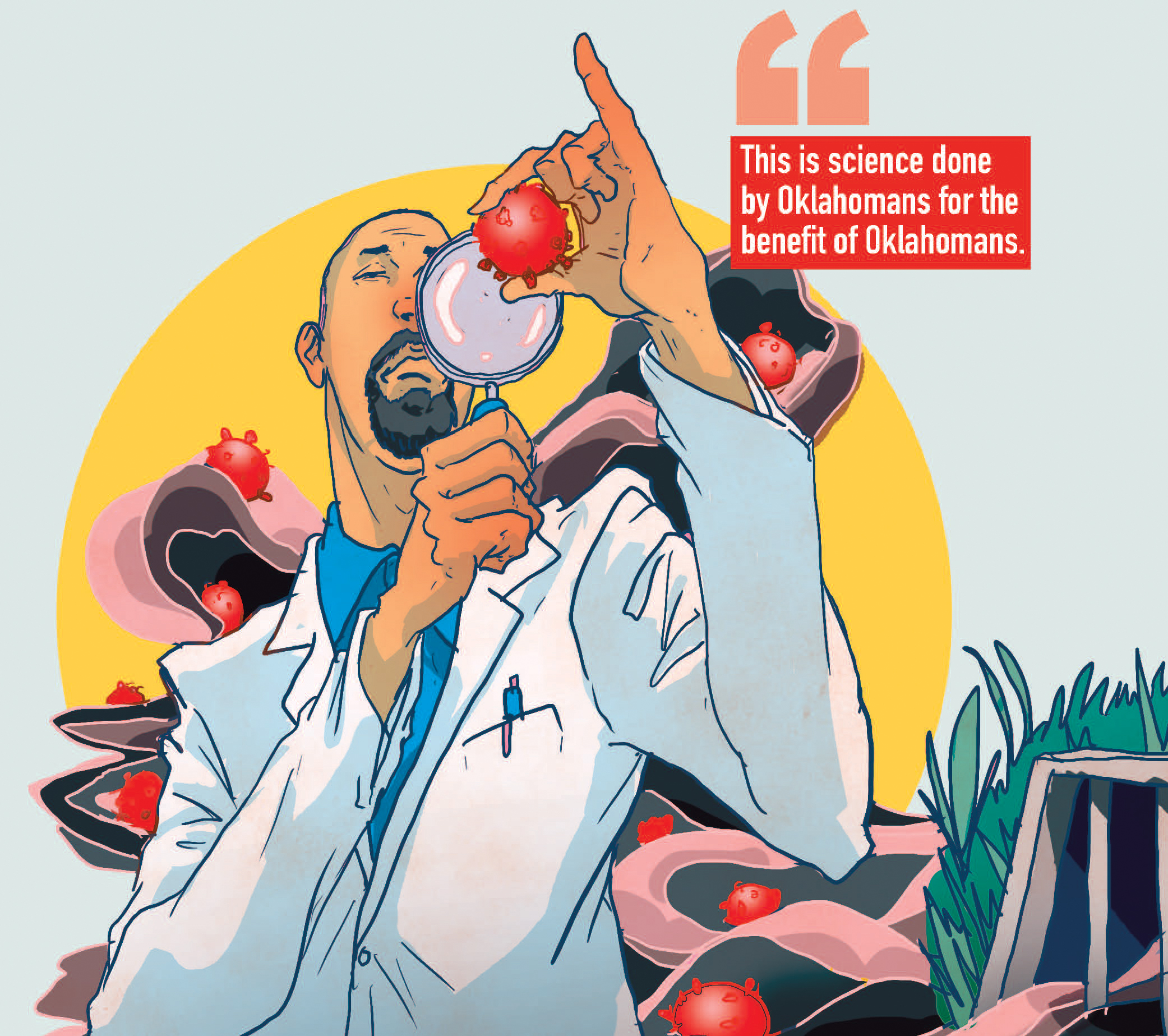
Illustration: @michaelbyers @levycreative
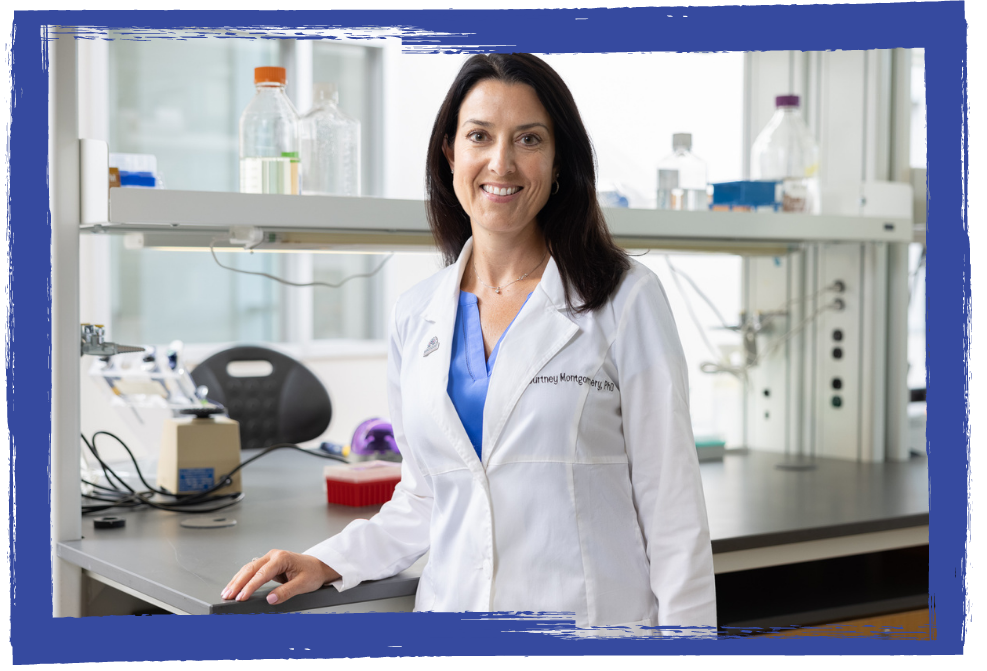




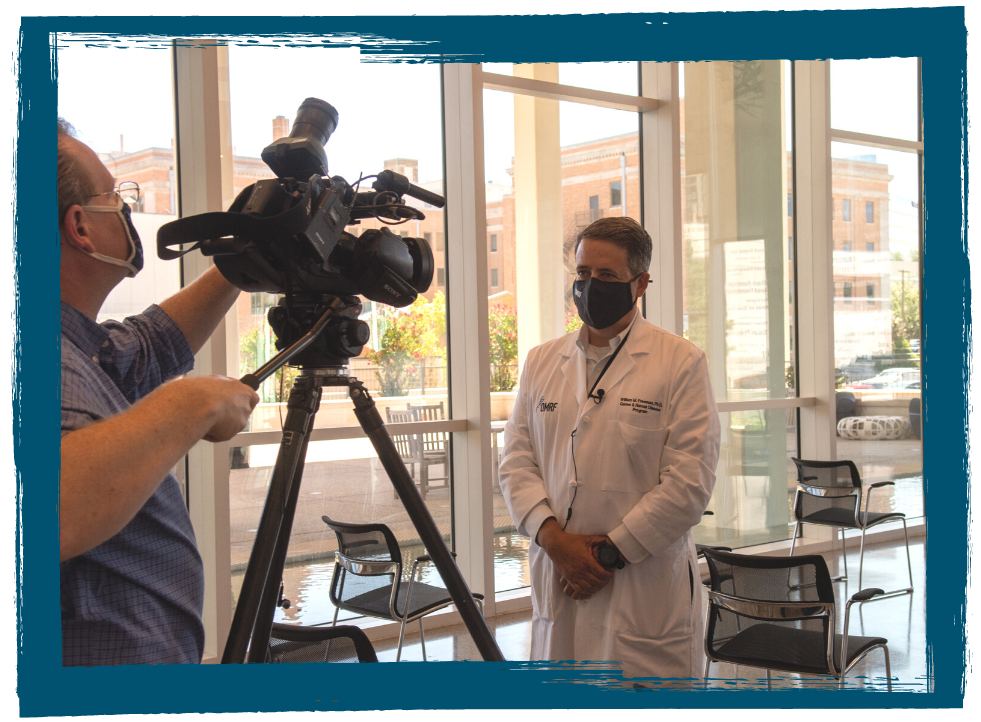


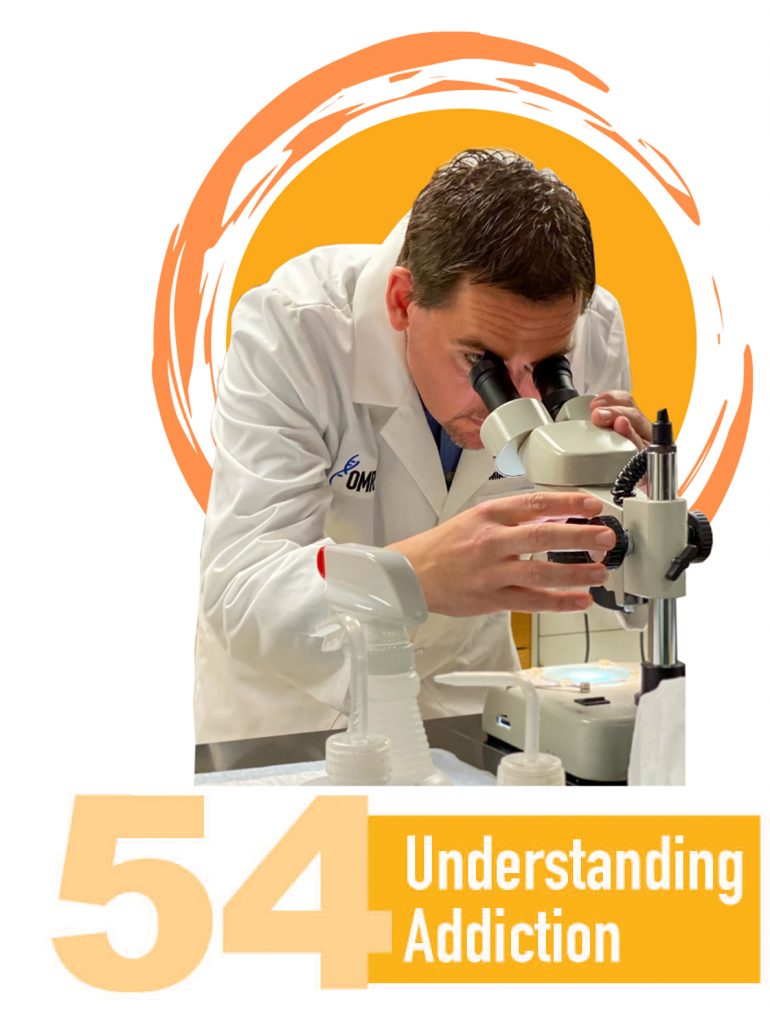
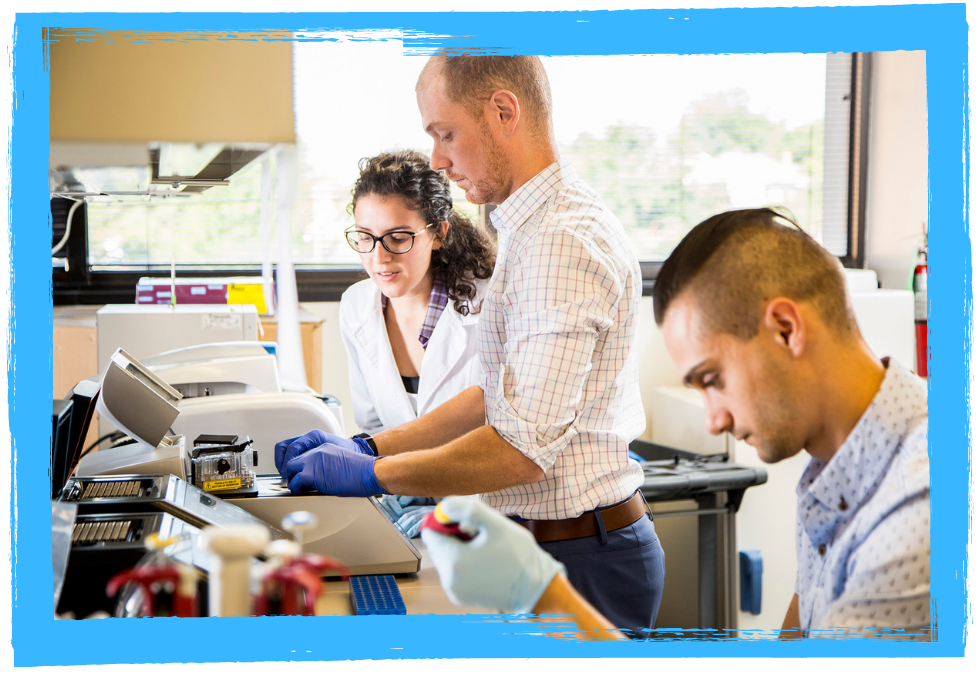


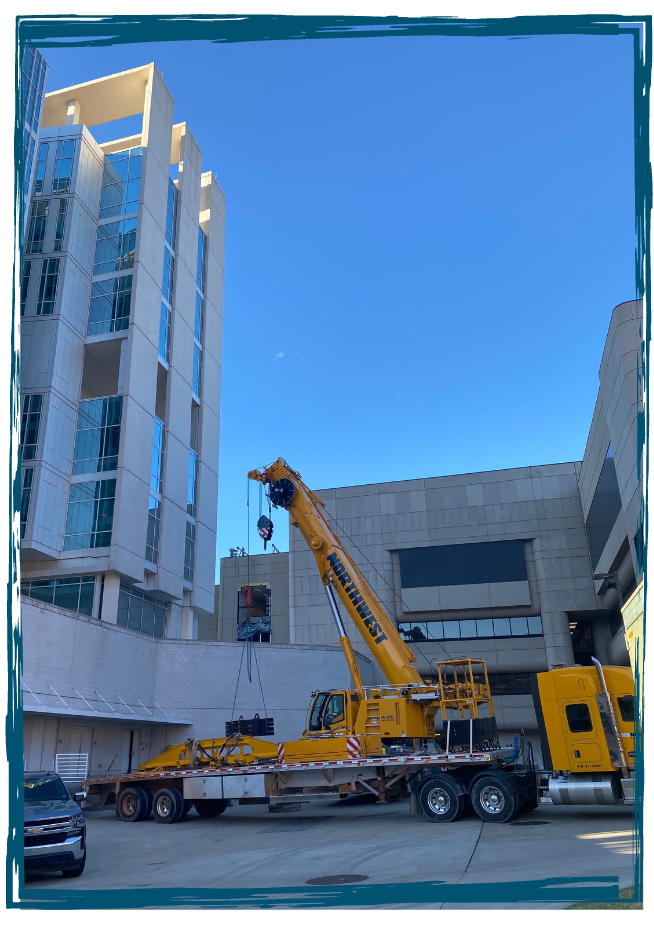


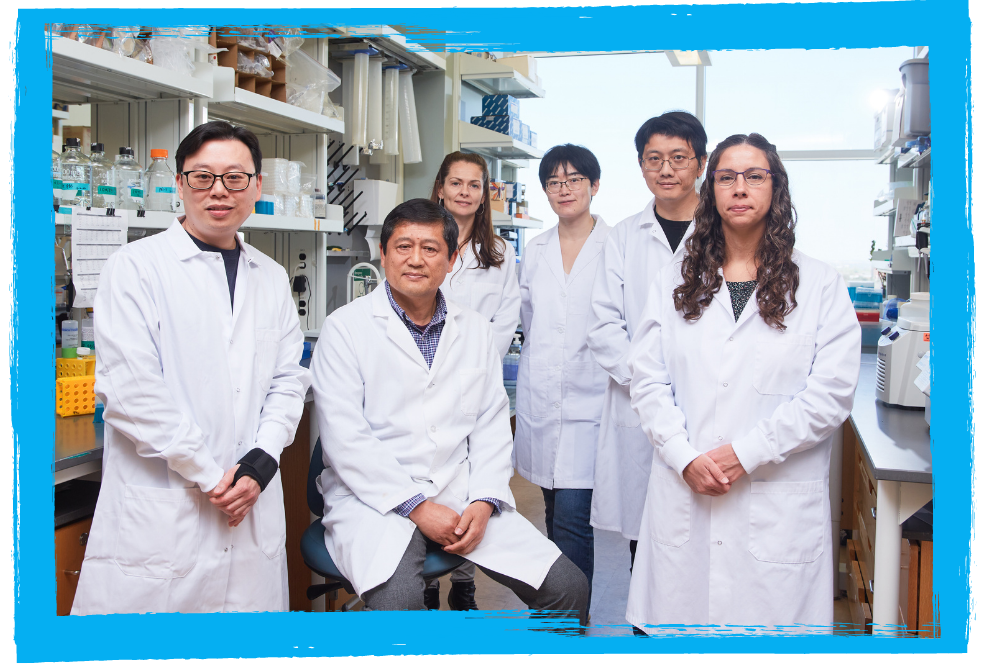



Illustration: Brian Taylor

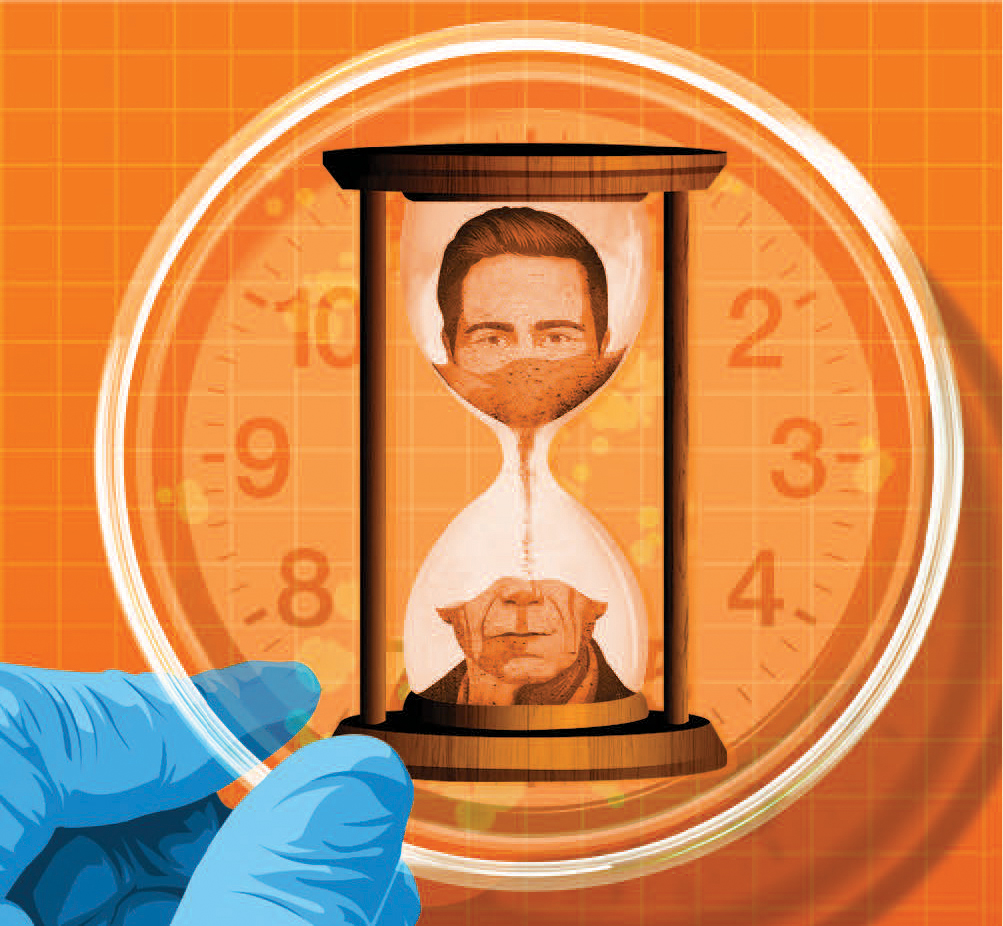
Illustration: Taylor Callery
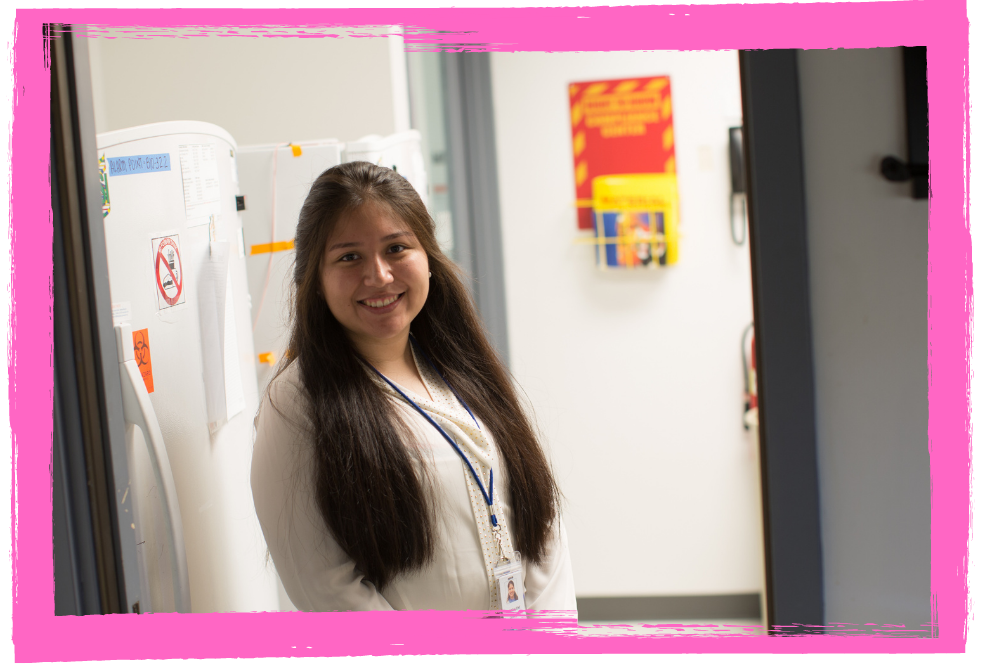
 Scientific American featured Magdalene Quintero in a major article about lupus. Quintero lives with the disease and works as an assistant clinical coordinator in OMRF’s Rheumatology Research Center of Excellence, helping patients with lupus and other autoimmune conditions. Under the mentorship of OMRF Vice President of Clinical Affairs Dr. Judith James, Quintero has set her sights on medical school or a physician assistant program, with the aim of improving outcomes for patients with lupus.
Scientific American featured Magdalene Quintero in a major article about lupus. Quintero lives with the disease and works as an assistant clinical coordinator in OMRF’s Rheumatology Research Center of Excellence, helping patients with lupus and other autoimmune conditions. Under the mentorship of OMRF Vice President of Clinical Affairs Dr. Judith James, Quintero has set her sights on medical school or a physician assistant program, with the aim of improving outcomes for patients with lupus.
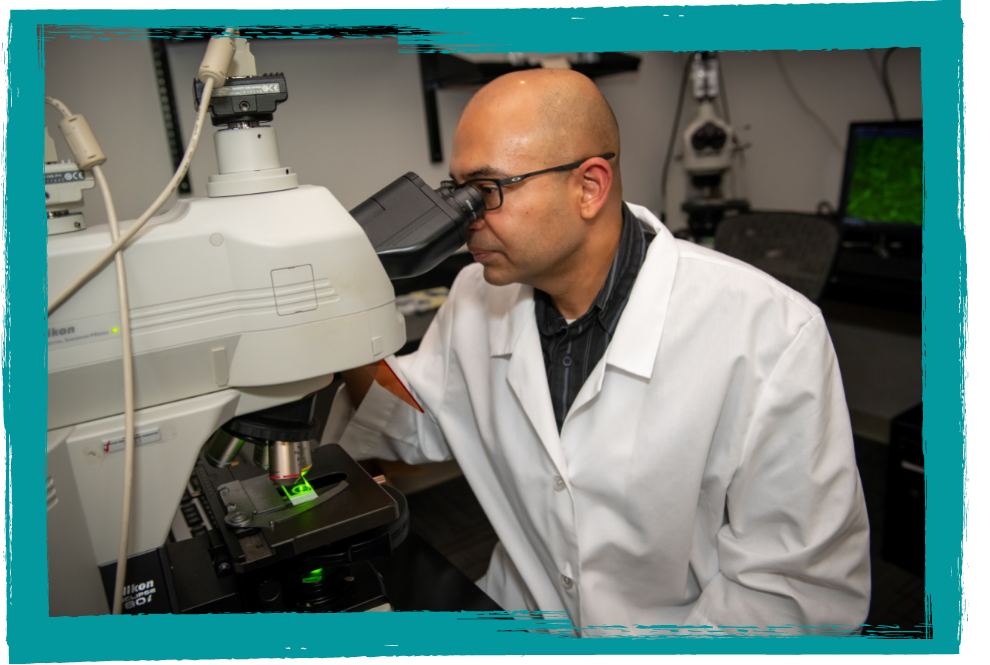


 Budd and Linda Parrish met while working at Tinker Air Force Base and married in 1970. Their careers in engineering and technology launched a crisscross tour of the U.S. and the globe, taking them from New York and Maryland to California, abroad to Japan, and eventually home to Harrah, Oklahoma, where Linda was born and raised. “Life in Japan was a wonderful experience for both of us, and every day was an adventure,” the Parrishes wrote for the Harrah Historical Society in 1998. “Although it was nice to return to Oklahoma, there was also a feeling of sadness at leaving Japan and the people and places we had grown to love.” In their retirement, the pair focused on becoming reacquainted with the Sooner State and small-town living. They had no children but were happy to have the time to invest in passions like historic preservation. Linda developed Alzheimer’s disease and died in 2015, and Budd passed away four years later. The couple left their estate to OMRF, and when it closed in 2021, the foundation received a gift of $1.2 million. Like many planned gifts, this one came with its share of mystery. “Mr. Parrish made just one call to us almost a decade ago,” says OMRF Senior Director of Development Sonny Wilkinson. “He shared their plans to name the foundation as a beneficiary of their estate but left few other details. We aren’t sure why the Parrishes selected OMRF, but we’re thankful they did.”
Budd and Linda Parrish met while working at Tinker Air Force Base and married in 1970. Their careers in engineering and technology launched a crisscross tour of the U.S. and the globe, taking them from New York and Maryland to California, abroad to Japan, and eventually home to Harrah, Oklahoma, where Linda was born and raised. “Life in Japan was a wonderful experience for both of us, and every day was an adventure,” the Parrishes wrote for the Harrah Historical Society in 1998. “Although it was nice to return to Oklahoma, there was also a feeling of sadness at leaving Japan and the people and places we had grown to love.” In their retirement, the pair focused on becoming reacquainted with the Sooner State and small-town living. They had no children but were happy to have the time to invest in passions like historic preservation. Linda developed Alzheimer’s disease and died in 2015, and Budd passed away four years later. The couple left their estate to OMRF, and when it closed in 2021, the foundation received a gift of $1.2 million. Like many planned gifts, this one came with its share of mystery. “Mr. Parrish made just one call to us almost a decade ago,” says OMRF Senior Director of Development Sonny Wilkinson. “He shared their plans to name the foundation as a beneficiary of their estate but left few other details. We aren’t sure why the Parrishes selected OMRF, but we’re thankful they did.”Illustration: Anna Heigh
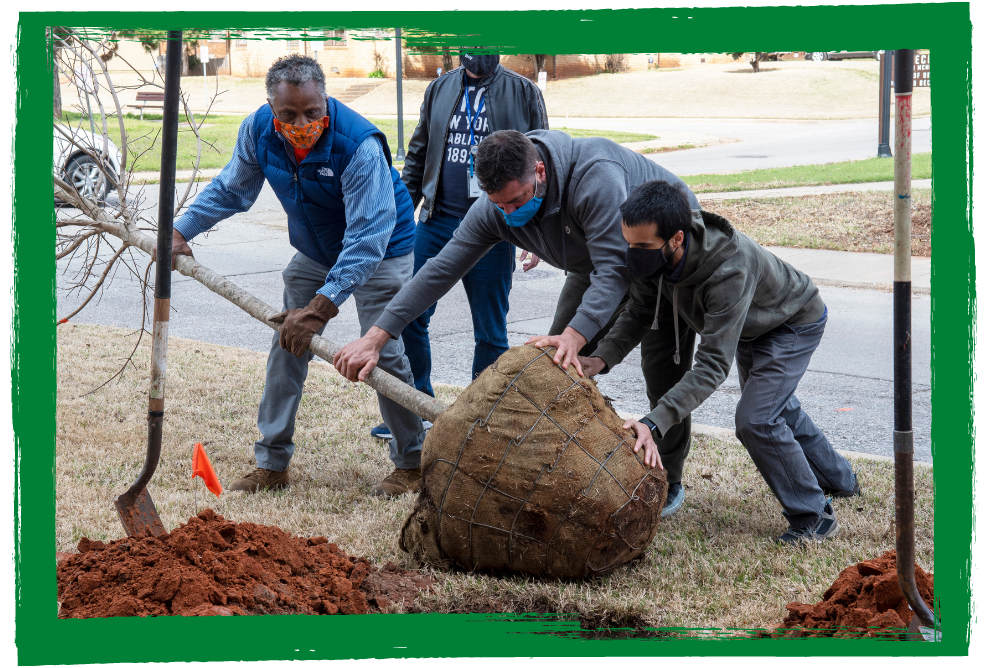


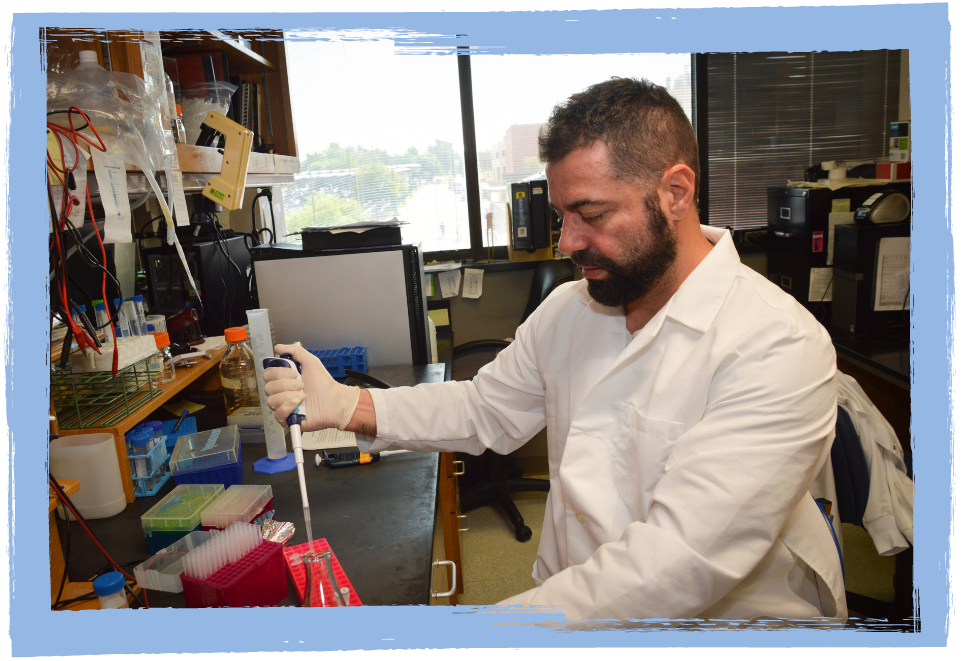


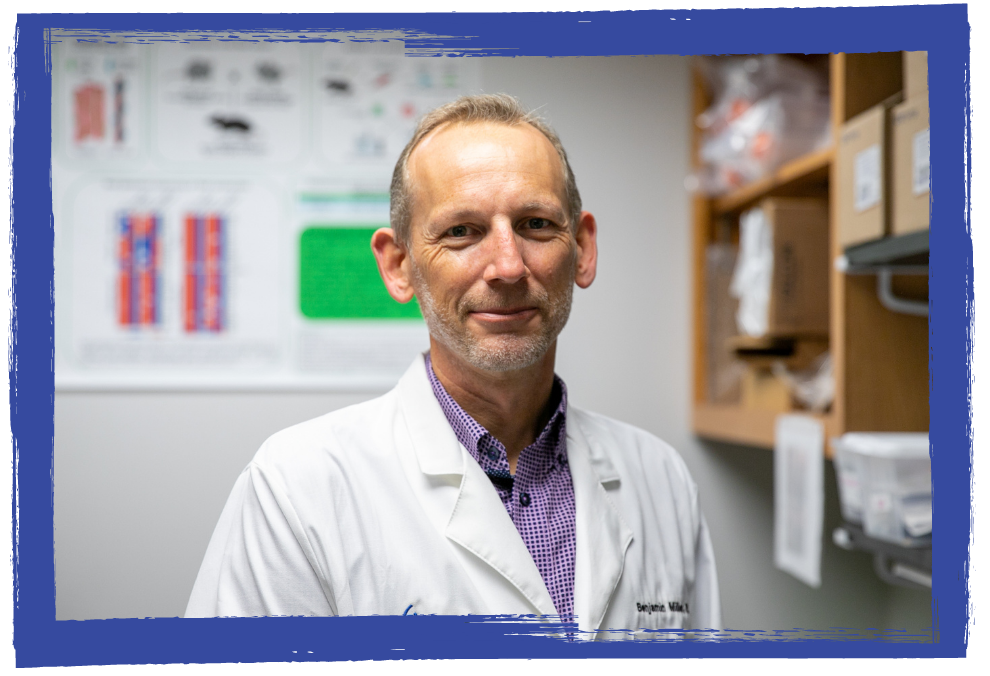

Dr. Benjamin Miller is leading a study to investigate whether a diabetes drug can slow aging. In a clinical trial in adults ages 40 to 75, he’s examining how metformin, the world’s most prescribed medication for diabetes, impacts insulin sensitivity and its link to the biological process of aging. “Aging is the leading risk factor for all chronic diseases,” says Miller, a physiologist. “If we can slow the process, we may simultaneously slow or prevent the onset of conditions like cancer, cardiovascular disease, Alzheimer’s and dementia.”


Sure, “So that more may live longer, healthier lives” has a nice ring. But how about “Loud, fast and pretty hardcore”? That’s how Joe Woodward, a supervisor in OMRF’s Department of Comparative Medicine, describes the music of Potoo, the band he formed with a group of fellow OMRFers. Named for a South American bird known for its large eyes and haunting, high-pitched call, the band consists of Woodward, postdoctoral researcher Dr. Jacob Brown, research technician Taylor Conner, and OMRF Research Café chef Chase Pierce. In between viral surges, the rockers played a few shows over the summer. They also released their debut album, “The First and the Last,” which can be streamed on Apple Music and Spotify. Dr. Tim Griffin, who took in one of Potoo’s live performances, is glad to see the quartet has formed bonds that extend beyond the foundation’s walls. “It’s important to create an environment where folks are interested in each other as whole people, not just as coworkers.”


Now known professionally as Bartees Strange, former OMRF intern Bartees Cox Jr. hit it big in 2021 when he dropped his first album of original work, “Live Forever.” Loosely categorized as indie rock, the eclectic collection includes Oklahoma-inflected titles like “Boomer” and “Mustang.” Rolling Stone sang the album’s praises and dubbed Strange an “Artist You Need to Know.” He performed on “Late Night with Seth Meyers” and at the Pitchfork Music Festival in Chicago. Strange says his days working in OMRF’s Department of Public Affairs, where he penned press releases and a piece for Findings magazine, still represent a special time in his life. “It was the first moment where I thought, ‘I can do things.’” He’s lined up an ambitious national touring slate for 2022, including a stop at Oklahoma City’s Tower Theatre.
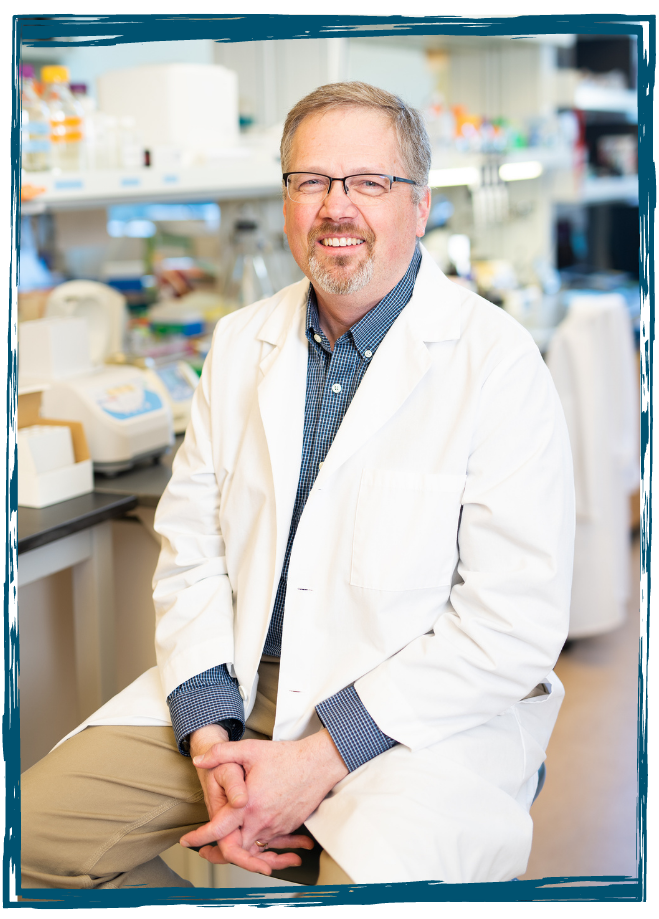

OMRF’s Dr. Patrick Gaffney teamed with Dr. Jason Buenrostro of Harvard University to secure a five-year, $4.1 million grant to investigate the role of genetics in the development of lupus. The pair will study how the DNA of people with lupus differs from those without the disease. “In recent years, we’ve made great progress in uncovering the genetic changes that predispose certain people to lupus,” Gaffney says. “Now we need to go further into the weeds to understand what these changes do to DNA’s function.” The pair will also investigate the distinctions in the genetic makeup of European Americans and African Americans with lupus, which disproportionately affects people of color.


The pandemic didn’t stop OMRF from welcoming a new class of students to its Visiting Research Graduate Traineeship Program. In partnership with the Fulbright Commission, OMRF is one of four institutions (along with the universities of Chicago, Virginia and Texas) that serves as a yearlong home for students enrolled in master’s degree programs in biomedical sciences in Poland. “It’s been a great addition to OMRF because it brings young, energetic students to our labs,” says Dr. Umesh Deshmukh, who started the program at OMRF in 2013. Following their stints at OMRF, the students return to Poland to finish their degrees. Increasingly, they’re then enrolling in Ph.D. programs at the University of Oklahoma. “And that is one of our aims,” Deshmukh says, “to bring international talent to Oklahoma, expose them to top-notch science, and get them excited about continuing their research.”
Illustration: Anna Heigh


Throughout the pandemic, OMRF scientists have partnered with journalists to ensure the public receives reliable health information. Dr. Stephen Prescott led that effort, separating medical fact from fiction in newspapers and on local television news even in the months leading up to his death. “He was Oklahoma’s Dr. Fauci when we all needed someone we could trust and turn to with all of the noise that surrounded the pandemic,” wrote one columnist in The Oklahoman. After Prescott passed away in May 2021, a team of OMRF physician-scientists assumed that mantle. Dr. Eliza Chakravarty, who’s done dozens of interviews for Covid-19 stories, believes she and her colleagues have a duty to serve as honest brokers and translators. “It’s important that scientists take the time to review the actual data, distill it down so it’s more easily understandable, and then work with the media to make it available to the public,” she says.
Illustration: Chris Gash/Brian Taylor

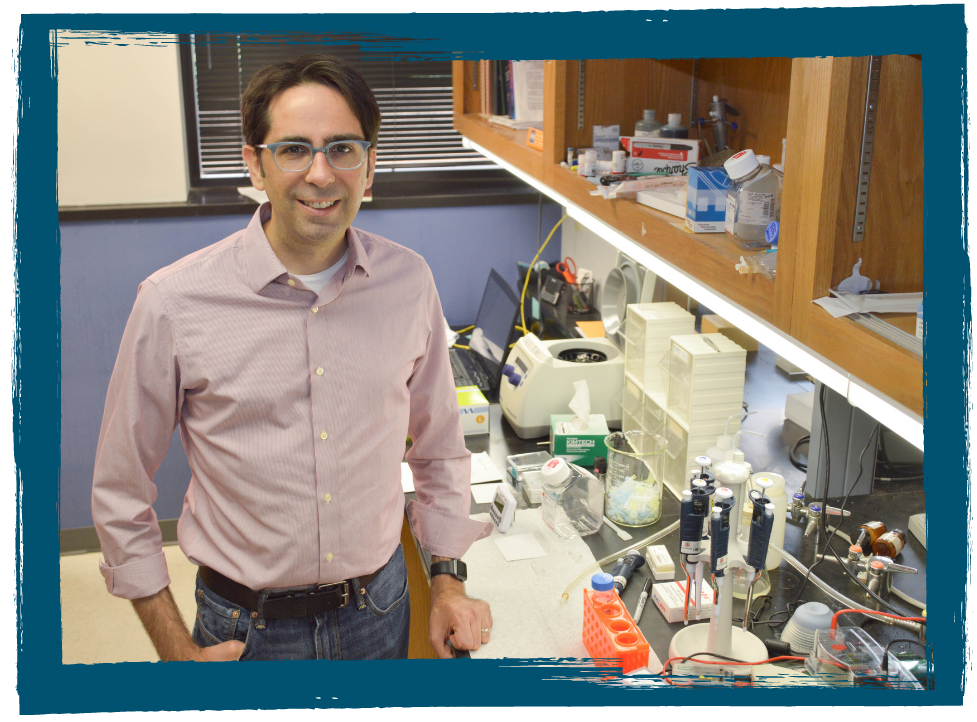
New OMRF research pinpointed a cellular switch tied to why diabetes harms the heart. “We are excited because we think if we can activate or help this broken switch, it might keep the heart more flexible, which would diminish some of the effects diabetes has on the heart and potentially reduce the likelihood of developing life-threatening heart conditions,” says Dr. Kenneth Humphries, who led the study. He published the findings in the Journal of the American Heart Association.


Illustration: @czillustration @levycreative


